Thermal Influence of Volcanic Tephra on Maximum Soil Temperatures: Geoecological Implications for Germination and Distribution of Argyroxiphium sandwicense (Haleakalā, Maui, Hawai’i)
Abstract
1. Introduction: The Scope of the Project
1.1. Beneficial Effects of Nurse Rocks and Nurse Plants
1.2. Significance of the Haleakalā Silversword and of Volcanic Tephra Covers in the Crater
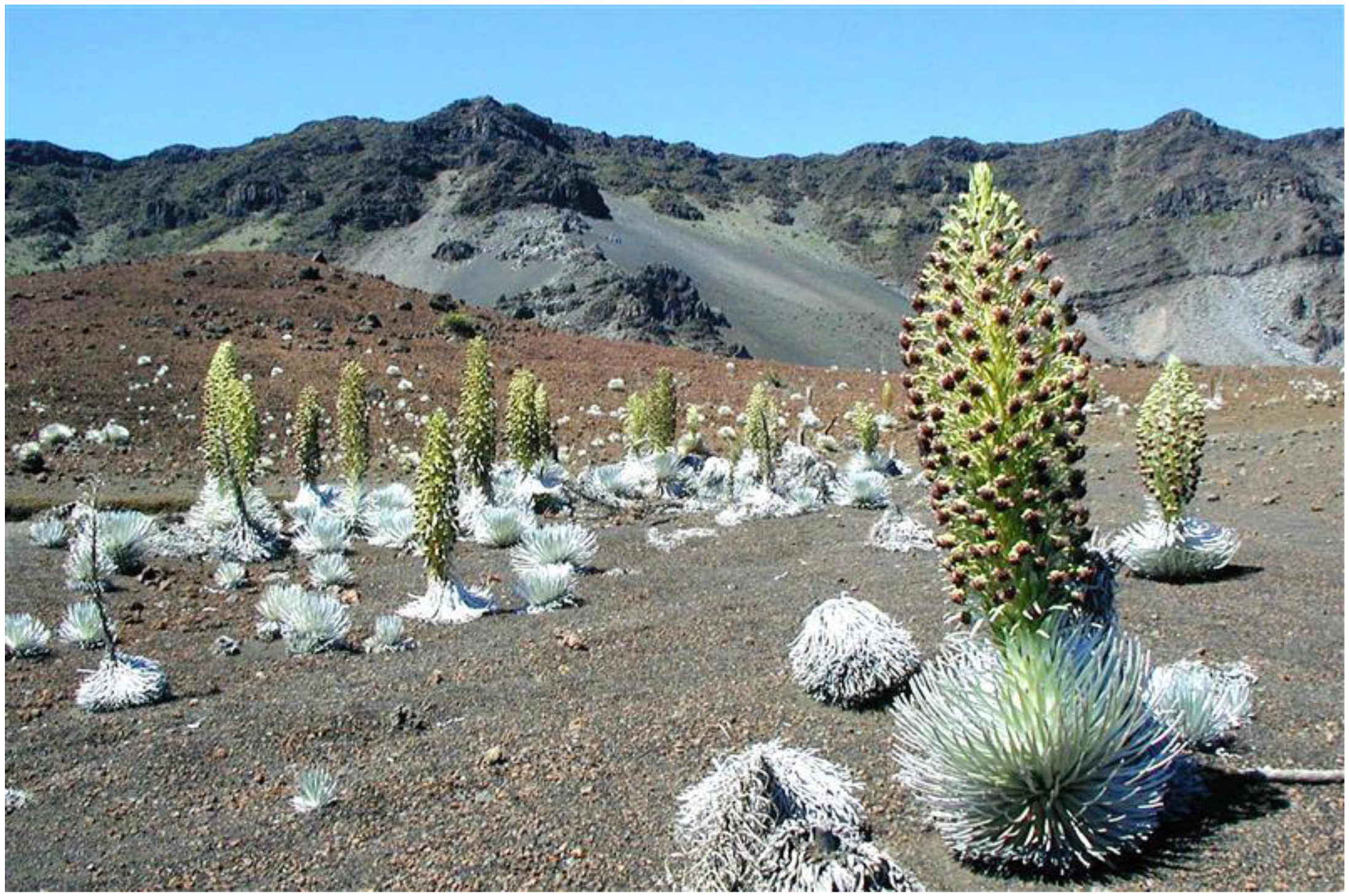
1.3. General Focus and Purpose of This Study
2. Study Methods
2.1. Fieldwork Procedures and Observations
2.2. Analytical Methods
3. Study Area: Haleakalā Crater
4. Results
4.1. Diversity and Characteristics of Black Tephra Covers and Environments in Haleakalā
4.2. Diversity and Characteristics of Reddish Tephra Covers and Environments in Haleakalā
4.3. Additional Nurse Microsites: Ground Shading by Silverswords and Rosette Organic Matter
4.4. Substrate Temperature Measurements in Different Microsites
4.5. Significance of Tephra Depth and Silversword Size for Ground Temperatures
5. Discussion
5.1. Features of Tephra Environments in Haleakalā
5.2. Other Positive Effects of Tephra Covers
5.3. Thermal Effects of Tephra Covers and Other Nurse Objects
5.4. Thermal Effects of Silversword Shade and Organic Litter
5.5. Role of Additional Effects of Tephra and Silversword Plants
5.6. Additional Biological and Environmental Factors Influencing Germination
5.7. Potential Human Effects, and Management Considerations
6. Conclusions: Influences of Different Microsite Types on Silversword Survival
- (i)
- Bare soils: These substrates seem the least adequate for rosette growth and survival. (a) Due to their overall surface uniformity and lack of rugosity, most soils have a limited ability to intercept incoming fog and thus do not receive much additional water beyond that provided by direct rainfall [1,11,12,95]; (b) owing to their high temperatures, exposed soils experience exceedingly high evaporation rates and subsequent drought, which may cause rapid plant wilting and/or death [11,12,41,95,97,113,114].
- (ii)
- Black tephra covers: In contrast to exposed soils, the rough, irregular tephra surfaces may help intercept much fog and drizzle, especially when facing the incoming trade winds; this would significantly increase the soil water content (see Section 5.5). (a) However, due to their high temperatures, substrates under black tephra fragments would still experience high evaporation rates, although these would be somewhat restrained by the clastic cover [95,97].
- (iii)
- Reddish tephra covers. These substrates undoubtedly provide the best locations for rosette survival, and areas with reddish fragments may achieve the highest silversword densities in the crater (see Section 4.2, and Figure 15). (a) The lower temperatures under reddish clasts would be associated with low evaporation rates [95]. (b) Like the black tephra, their uneven surface would allow significant fog interception and subsequent soil water storage.
- (iv)
- Shade of rosettes. (a) Due to the remarkably low temperatures in these substrates, evaporation rates would also be modest. These characteristics should presumably have made these locations conducive to satisfactory seed germination and survival; yet, it was not immediately clear why silverswords did not take advantage of such favorable substrates. (b) Plant competition for environmental resources—such as incoming light and soil water—might provide an explanation for this apparent inconsistency [8,25,29].
- (v)
- Silversword litter. (a) The low temperatures in soil patches covered by litter mounds would allow evaporation rates from insulated soils to remain low. (b) The long-term persistence of these organic matter piles, which can seemingly last 15 or 20 years before decomposing and disappearing, would make them stable, semi-permanent elements of the environment and desirable silversword locations. (c) However, the relative scarcity of these microsites in some plots limits their usefulness. (d) Seedling growth on litter mounds could also be restricted by their substantial thickness, which may reach 19.1 cm or perhaps a greater depth (Table 1), and the high water-retention capacity of litter limits effective water percolation to the soil beneath [95,97]. In any case, silversword seeds landing near the thinner edges of litter piles have a greater chance of survival and seem to be more common there (Figure 21). (e) A highly positive aspect of litter mounds is that decomposing rosettes gradually release comparatively large amounts of nutrients, including N, Mg, K, and P—normally in short supply in volcanic soils—raising their levels ~4 to 6 times in the soil, right next to seedlings, where these can readily benefit from such soil enrichment [100].
Funding
Data Availability Statement
Acknowledgments
Conflicts of Interest
References
- Kobayashi, H.K. Ecology of the Silversword, Argyroxiphium sandwicense DC. (Compositae), Haleakala Crater, Hawaii. Ph.D. Dissertation, University of Hawaii, Manoa, HI, USA, 1973; p. 91. [Google Scholar]
- Weberbauer, A. Die Pflanzenwelt der peruanischen Anden. In Die Vegetation der Erde; Engler, A., Drude, O., Eds.; Wilhelm Engelmann: Leipzig, Germany, 1911; Volume 12, pp. 1–355. [Google Scholar]
- Weberbauer, A. El Mundo Vegetal de los Andes Peruanos. Estudio Fitogeográfico; Lumen, Ed.; Ministerio de Agricultura: Lima, Peru, 1945. [Google Scholar]
- Hedberg, O. Features of Afro-alpine plant ecology. Acta Phytogeogr. Suec. 1964, 49, 1–144. [Google Scholar]
- Parker, K.C. Site-related demographic patterns of organ pipe cactus populations in Southern Arizona. Bull. Torrey Bot. Club 1987, 114, 149–155. [Google Scholar] [CrossRef]
- Parker, K.C. Nurse plant relationships of columnar cacti. Phys. Geogr. 1989, 10, 322–335. [Google Scholar] [CrossRef]
- Flores, J.; Jurado, E. Are nurse-protégé interactions more common among plants from arid environments? J. Veg. Sci. 2003, 14, 911–916. [Google Scholar] [CrossRef]
- Munguia-Rosas, M.A.; Sosa, V.J. Nurse plants vs. nurse objects: Effects of woody plants and rocky cavities on the recruitment of the Pilosocereus leucocephalus columnar cactus. Ann. Bot. 2008, 101, 175–185. [Google Scholar] [CrossRef] [PubMed]
- Huey, R.B.; Peterson, C.R.; Arnold, S.J.; Porter, W.P. Hot rocks and not-so-hot rocks: Retreat-site selection by garter snakes and its thermal consequences. Ecology 1989, 70, 931–944. [Google Scholar] [CrossRef]
- Sedlacek, J. Demography and inbreeding depression in the rare, endemic Echium wildpretii (Boraginaceae). Msc. Thesis, Institute of Environmental Sciences, University of Zurich, Zurich, Switzerland, 2009; p. 38. [Google Scholar]
- Pérez, F.L. Phytogeomorphic influence of stone covers and boulders on plant distribution and slope processes in high-mountain areas. Geogr. Compass 2009, 3, 1774–1803. [Google Scholar] [CrossRef]
- Pérez, F.L. Hot soils and cooler stones: Geoecological influence of volcanic tephra and boulders on soil temperature, and significance for plant distribution in Haleakalā Crater (Maui, Hawaii). Catena 2017, 158, 9–19. [Google Scholar] [CrossRef]
- Noy-Meir, I. Ecology of wild emmer wheat in Mediterranean grasslands in Galilee. Israel. J. Plant Sci. 2001, 49, 43–52. [Google Scholar] [CrossRef]
- Fujita, T.; Mizuno, K. Role of nurse rocks on woody plant establishment in a South African grassland. Tropics 2015, 24, 57–64. [Google Scholar] [CrossRef]
- Conver, J.L.; Yarwood, E.; Hetherington, L.D.; Swann, D.E. Nurse rock microclimates significantly buffer exposure to freezing temperature and moderate summer temperature. J. Arid. Environ. 2020, 177, 104140. [Google Scholar] [CrossRef]
- Díazgranados, M. A nomenclator for the frailejones (Espeletiinae Cuatrec., Asteraceae). Phytokeys 2012, 16, 1–52. [Google Scholar] [CrossRef] [PubMed]
- Pérez, F.L. Long-term growth rates of two acaulescent rosette species, Coespeletia timotensis (Cuatrec.) Cuatrec. and Espeletia schultzii Wedd., in an Andean páramo. Flora 2019, 252, 1–9. [Google Scholar] [CrossRef]
- Carlucci, M.B.; Duarte, L.; Pillar, V.D. Nurse rocks influence forest expansion over native grassland in southern Brazil. J. Veg. Sci. 2011, 22, 111–119. [Google Scholar] [CrossRef]
- Nobel, P.S. Environmental Biology of Agaves and Cacti; Cambridge University Press: Cambridge, UK, 1988. [Google Scholar]
- Franco, A.C.; Nobel, P. Effect of nurse plants on the microhabitat and growth of cacti. J. Ecol. 1989, 77, 870–886. [Google Scholar] [CrossRef]
- Valiente-Banuet, A.; Ezcurra, E. Shade as a cause of the association between the cactus Neobuxbamia tetetzo and the nurse plant Mimosa luisana in the Tehuacán Valley, Mexico. J. Ecol. 1991, 79, 961–971. [Google Scholar] [CrossRef]
- Nobel, P.S.; Miller, P.M.; Graham, E.A. Influence of rocks on soil temperature, soil water potential, and rooting patterns for desert succulents. Oecology 1992, 92, 90–96. [Google Scholar] [CrossRef]
- Reyes-Olivas, A.; García, E.; López, L. Cacti-shrub interactions in the coastal desert of northern Sinaloa Mexico. J. Arid. Environ. 2002, 52, 431–445. [Google Scholar] [CrossRef]
- Gómez-Aparicio, L.; Gómez, J.; Zamora, R.; Boettinger, J.L. Canopy vs. soil effects of shrubs facilitating tree seedlings in Mediterranean montane ecosystems. J. Veg. Sci. 2005, 16, 191–198. [Google Scholar]
- Pérez, F.L. Needle-ice activity and the distribution of stem-rosette species in a Venezuelan paramo. Arct. Alp. Res. 1987, 19, 135–153. [Google Scholar]
- Kleier, C.; Rundel, P. Microsite requirements, population structure and growth of the cushion plant, Azorella compacta, in the tropical Chilean Andes. Austral Ecol. 2004, 29, 461–470. [Google Scholar] [CrossRef]
- Kleier, C.; Rundel, P. Energy balance and temperature relations of Azorella compacta, a high-elevation cushion plant of the central Andes. Plant Biol. 2009, 11, 351–358. [Google Scholar] [CrossRef] [PubMed]
- Kleier, C.; Lambrinos, J.G. The importance of nurse associations for three tropical alpine life forms. Arct. Antarct. Alp. Res. 2005, 37, 331–336. [Google Scholar] [CrossRef]
- Peters, E.M.; Martorell, C.; Ezcurra, E. Nurse rocks are more important than nurse plants in determining the distribution and establishment of globose cacti (Mammillaria) in the Tehuacán Valley, Mexico. J. Arid. Environ. 2008, 72, 593–601. [Google Scholar] [CrossRef]
- Haussmann, N.S.; McGeoch, M.A.; Boelhouwers, J.C. Contrasting nurse plants and nurse rocks: The spatial distribution of seedlings of two sub-Antarctic species. Acta. Oecol. 2010, 36, 299–305. [Google Scholar] [CrossRef]
- Wagner, W.L.; Herbst, D.R.; Sohmer, S.H. Manual of the Flowering Plants of Hawaii. In B.P. Bishop Museum Special Publication 83; University Hawaii Press: Honolulu, HI, USA, 1990; Volume 2. [Google Scholar]
- Rundel, P.W.; Witter, M.S. Population dynamics and flowering in a Hawaiian alpine rosette plant, Argyroxiphium sandwicense. In Tropical Alpine Environments; Rundel, P.W., Smith, A.P., Meinzer, F.C., Eds.; Cambridge University Press: Cambridge, UK, 1994; pp. 295–306. [Google Scholar]
- Alexander, W.D. On the crater of Haleakala, island of Maui, Hawaiian group. Am. J. Sci. Arts 1870, 49, 43–48. [Google Scholar] [CrossRef]
- Bird, I.L. The Hawaiian Archipelago: Six Months Among the Palm Groves, Coral Reefs, and Volcanoes of the Sandwich Islands; John Murray: London, UK, 1875. [Google Scholar]
- Pérez, F.L. Early uses by ancient Hawaiians, and environmental, geographical, and ecological history of Haleakalā Crater, East Maui. Geographies 2024, 4, 378–410. [Google Scholar] [CrossRef]
- Yocom, C.F. Ecology of feral goats in Haleakala National Park, Maui, Hawaii. Am. Midl. Nat. 1967, 77, 418–451. [Google Scholar] [CrossRef]
- Loope, L.L.; Medeiros, A.C. Biotic interactions in Hawaiian high elevation ecosystems. In Tropical Alpine Environments; Rundel, P.W., Smith, A.P., Meinzer, F.C., Eds.; Cambridge University Press: Cambridge, UK, 1994; pp. 337–354. [Google Scholar]
- Bruegmann, M.M. Protecting habitat for silversword recovery. Endanger. Species Bull. 1995, 20, 6–7. [Google Scholar]
- Pérez, F.L. Spatial aggregation patterns and population structure of the Haleakalā silversword (Argyroxiphium sandwicense DC. subsp. macrocephalum), Maui, Hawaii. Phys. Geogr. 2014, 36, 34–59. [Google Scholar] [CrossRef]
- Krushelnycky, P.D.; Loope, L.L.; Giambelluca, T.W.; Starr, F.; Starr, K.; Drake, D.R.; Taylor, A.D.; Robichaux, R.H. Climate-associated population declines reverse recovery and threaten future of an iconic high-elevation plant. Glob. Change Biol. 2013, 19, 911–922. [Google Scholar] [CrossRef]
- Krushelnycky, P.D.; Felts, J.M.; Robichaux, R.H.; Barton, K.E.; Litton, C.M.; Brown, M.D. Clinal variation in drought resistance shapes past population declines and future management of a threatened plant. Ecol. Monogr. 2020, 90, e301398. [Google Scholar] [CrossRef]
- U. S. Fish and Wildlife Service. Final listing rules for 53 species, 1992. Endanger. Species Technol. Bull. 1992, 17, 15. [Google Scholar]
- Wilkes, C. Narrative of the United States Exploring Expedition During the Years 1838, 1839, 1840, 1841, 1842; Lea & Blanchard: Philadelphia, PA, USA, 1845; Volume 4. [Google Scholar]
- Wentworth, C.K.; MacDonald, G.A. Structures and forms of basaltic rocks in Hawaii. United States Geol. Surv. Bull. 1953, 994, 1–98. [Google Scholar]
- MacDonald, G.A. Forms and structures of extrusive basalt rocks. In Basalts: The Poldervaart Treatise on Rocks of Basaltic Composition; Hess, H.H., Poldervaart, A., Eds.; Wiley Interscience: New York, NY, USA, 1967; Volume 1, pp. 1–62. [Google Scholar]
- Schwertmann, U. Relations Between Iron Oxides, Soil Color, and Soil Formation. In Soil Color; Bigham, J.M., Ciolkosz, E.J., Eds.; Soil Science Society of America Special Publications: Madison, WI, USA, 1993; Volume 31, pp. 51–69. [Google Scholar]
- Post, D.F.; Fimbres, A.; Matthias, A.D.; Sano, E.E.; Accioly, L.; Batchily, A.K.; Ferreira, L.G. Predicting soil albedo from soil color and spectral reflectance data. Soil Sci. Soc. Am. J. 2000, 64, 1027–1034. [Google Scholar] [CrossRef]
- Bigham, J.M.; Golden, D.C.; Buol, S.W.; Weed, S.B.; Bowen, L.H. Iron oxide mineralogy of well drained Ultisols and Oxisols: II. Influence on color, surface area, and phosphate retention. Soil Sci. Soc. Am. J. 1978, 42, 825–830. [Google Scholar] [CrossRef]
- Torrent, J.; Schwertmann, U. Influence of hematite on the color of red beds. J. Sediment. Petrol. 1987, 57, 682–686. [Google Scholar]
- USA Soil Survey Geographic Database (SSURGO). Soil Albedo; USDA, Dept. of Agriculture, Natural Resources Conservation Service, 2017. Available online: https://www.arcgis.com/home/item.html?id=e89fdc8e8b13417daa5ad232312f58cf#:~:text=This%20layer%20displays%20the%20ratio,and%20reflected%20by%20the%20soil (accessed on 14 November 2024).
- Munsell Soil Color Charts; Macbeth, Kollmorgen Instruments: Newburgh, NY, USA, 1992.
- Thompson, J.A.; Pollio, A.R.; Turk, P.J. Comparison of Munsell soil color charts and the GLOBE soil color book. Soil Sci. Soc. Am. J. 2013, 77, 2089–2093. [Google Scholar] [CrossRef]
- Graser, E.A.; van Bavel, C.H.M. The effect of soil moisture upon soil albedo. Agric. Meteorol. 1982, 27, 17–26. [Google Scholar] [CrossRef]
- Sugathan, N.; Biju, V.; Renuka, G. Influence of soil moisture content on surface albedo and soil thermal parameters at a tropical station. J. Earth Syst. 2014, 125, 1115–1128. [Google Scholar] [CrossRef]
- Cierniewski, J.; Ceglarek, J.; Karnieli, A.; Królewicz, S.; Kazmierowski, C.; Zagajewski, B. Predicting the diurnal blue-sky albedo of soils using their laboratory reflectance spectra and roughness indices. J. Quant. Spectrosc. Radiance Transf. 2017, 200, 25–31. [Google Scholar] [CrossRef]
- Siegel, S.M.; Carroll, P.; Corn, C.; Speitel, T. Experimental studies on the Hawaiian silverswords (Argyroxiphium spp.): Some preliminary notes on germination. Bot. Gaz. 1970, 131, 277–280. [Google Scholar] [CrossRef]
- Walker, L.R.; Powell, E.A. Factors affecting seed germination of the Mauna Kea silversword in Hawaii. Pac. Sci. 1995, 49, 205–211. [Google Scholar]
- Walker, L.R.; Powell, E.A. Regeneration of the Mauna Kea silversword Argyroxiphium sandwicense (Asteraceae) in Hawaii. Biol. Conserv. 1999, 89, 61–70. [Google Scholar] [CrossRef]
- Macdonald, G.A. Geologic Map of the Crater Section of Haleakala National Park, Maui, Hawaii, U.S. Geological Survey Miscellaneous Investigations Series Map I-1088 (s1:24,000), with Report: Summary of the Geology of Haleakala. 1–8 pp + map. 1978. Available online: https://www.usgs.gov/maps/geologic-map-crater-section-haleakala-national-park-maui-hawaii (accessed on 12 May 2015).
- Jury, W.A.; Bellantuoni, B. Heat and water movement under surface rocks in a field soil: I Thermal effects. Soil Sci. Soc. Am. J. 1976, 40, 505–509. [Google Scholar] [CrossRef]
- ASTM. Manual on the Use of Thermocouples in Temperature Measurement, 4th ed.; ASTM International Manual Series: MNL 12, Revision of Special Technical Publication 470B; ASTM: Baltimore, MD, USA, 1993. [Google Scholar]
- GSA. Rock-Color Chart, 7th ed.; Geological Society of America: Boulder, CO, USA, 1991. [Google Scholar]
- Munsell Color Charts for Plant Tissues; Macbeth, Kollmorgen Instruments: Baltimore, MD, USA, 1997.
- Hoaglin, D.C.; Mosteller, F.; Tukey, J.W. Understanding Robust and Exploratory Data Analysis; Wiley: New York, NY, USA, 1983. [Google Scholar]
- Tukey, J.W. Exploratory Data Analysis; Addison-Wesley: Boston, MA, USA, 1977. [Google Scholar]
- Frigge, M.; Hoaglin, D.G.; Iglewicz, B. Some implementations of the Boxplot. Am. Stat. 1989, 43, 50–54. [Google Scholar] [CrossRef]
- Brillinger, D.R. Data Analysis, Exploratory; SAGE Publications: Statistics Department University of California Berkeley: Berkeley, CA, USA, 2011; pp. 530–537. Available online: https://stat.berkeley.edu (accessed on 16 July 2024).
- Iglewicz, B.; Hoaglin, D.G. Use of boxplots for process evaluation. J. Qual. Technol. 1987, 19, 180–190. [Google Scholar] [CrossRef]
- Hoaglin, D.C.; John, W. Tukey and data analysis. Stat. Sci. 2003, 18, 311–318. [Google Scholar] [CrossRef]
- Reio, T.G.; Shuck, B. Exploratory Factor Analysis: Implications for theory, research, and practice. Adv. Dev. Hum. Resour. 2015, 17, 12–25. [Google Scholar] [CrossRef]
- Hu, K. Become competent within one day in generating boxplots and violin plots for a novice without prior R experience. Methods Protoc. 2020, 3, 64. [Google Scholar] [CrossRef]
- McGill, R.; Tukey, J.W.; Larsen, W.A. Variations of box plots. Am. Stat. 1978, 32, 12–16. [Google Scholar] [CrossRef]
- Krzywinski, M.; Altman, N. Visualizing samples with box plots. Nat. Methods 2014, 11, 119–120. [Google Scholar] [CrossRef] [PubMed]
- Williamson, D.F.; Parker, R.A.; Kendricks, J.S. The box plot: A simple visual method to interpret data. Ann. Intern. Med. 1989, 110, 916–992. [Google Scholar] [CrossRef]
- Thirumalai, C.; Manickan, V.; Balaji, R. Data Analysis Using Box and Whisker Plot for Lung Cancer, Proceedings of the IEEE International Conference on Innovations in Power and Advancing Computing Technologies [i-PACT2017], Vellore, India, 21–22 April 2017; Institute of Electrical and Electronics Engineers: Piscataway Township, NJ, USA, 2017; pp. 1–6. [Google Scholar]
- Willmott, C.J.; Robeson, S.C.; Matsuura, K. Geographic box plots. Phys. Geogr. 2007, 28, 331–344. [Google Scholar] [CrossRef][Green Version]
- Perkins, R.B.; Mason, C.E. The relative mobility of trace elements from short-term weathering of a black shale. Appl. Geochem. 2015, 56, 67–79. [Google Scholar] [CrossRef]
- Pérez, F.L. Cryptogams build up a living microcosm: Geoecological effects of biocrusts on volcanic tephra (Haleakalā, Maui, Hawaii). Catena 2021, 203, 105320. [Google Scholar] [CrossRef]
- Choi, C.h.-Y.; Battley, P.F.; Potter, M.A.; Ma, Z.; Liu, W. Factors affecting the distribution patterns of benthic invertebrates at a major shorebird staging site in the Yellow Sea, China. Wetlands 2014, 34, 1085–1096. [Google Scholar] [CrossRef]
- Joshi, R.S.; Rigau, M.; García-Prieto, C.A.; de Moura, M.C.; Piñeyro, D.; Moran, S.; Davalos, V.; Carrión, P.; Ferrando-Bernal, M.; Olalde, I.; et al. Look-alike humans identified by facial recognition algorithms show genetic similarities. Cell Rep. 2022, 40, 111257. [Google Scholar] [CrossRef]
- Spitzer, M.; Wildenhain, J.; Rallsilber, J.; Tyers, M. BoxplotR: A web tool for generation of box plots. Nat. Methods 2014, 11, 121–122. [Google Scholar] [CrossRef]
- Iglewicz, B.; Hoaglin, D.G. How to Detect and Handle Outliers; American Association for Quality Control, Statistics Division: Milwaukee, IL, USA, 1993; Volume 16. [Google Scholar]
- Miller, R.L.; Kahn, J.S. Statistical Analysis in the Geological Sciences; Wiley: New York, NY, USA, 1962. [Google Scholar]
- Stearns, H.T. Origin of the Haleakala crater, island of Maui, Hawaii. Geol. Soc. Am. Bull. 1942, 53, 1–14. [Google Scholar] [CrossRef]
- Macdonald, G.A.; Abbott, A.T.; Peterson, A.T. Volcanoes in the Sea. The Geology of Hawaii; University Hawaii Press: Honolulu, HI, USA, 1983. [Google Scholar]
- Sherrod, D.R.; Nishimitsu, Y.; Tagami, T. New K-Ar ages and the geologic evidence against rejuvenated-stage volcanism at Haleakalā, East Maui, a postshield volcano of the Hawaiian island chain. GSA Bull. 2003, 115, 683–694. [Google Scholar] [CrossRef]
- Sherrod, D.R.; Sinton, J.M.; Watkins, S.E.; Brunt, K.M. Geologic Map of the State of Hawaii. U.S. Geological Survey Scientific Investigations Map 3143. pamphlet 72 p., 5 sheets, scales 1:100,000 and 1:250,000. 2021. Available online: https://doi.org/10.3133/sim3143 (accessed on 22 April 2022).
- Pérez, F.L. Growth of Grimmia mosses on volcanic tephra: Geoecological processes of biocrust development in Haleakalā Crater (Maui, Hawaii). Catena 2020, 195, 104911. [Google Scholar] [CrossRef]
- USGS. The Age of Young Lava Flows on Haleakala’s Crater Floor, East Maui Volcano. USGS Hawaii Volcano Observatory. 2003. Available online: www.accuracyingenesis.com/haleak.html (accessed on 20 May 2020).
- Sherrod, D.R.; Hagstrum, J.T.; McGeehin, J.P.; Champion, D.E.; Trusdell, F.A. Distribution, 14C chronology, and paleomagnetism of latest Pleistocene and Holocene lava flows at Haleakalā volcano, Island of Maui, Hawaii: A revision of lava flow hazard zones. J. Geophys. Res. 2006, 111, B05205. [Google Scholar] [CrossRef]
- Pérez, F.L. Biogeomorphic influence of soil depth to bedrock, volcanic-ash soils, and surface tephra on silversword distribution, Haleakalā Crater (Maui, Hawaii). Geomorphology 2015, 243, 75–86. [Google Scholar] [CrossRef]
- Blumenstock, D.I.; Price, S. Climate of Hawaii. In Climates of the States; N° 60-51; Climatography of the United States, United States, US Department of Commerce: Washington, DC, USA, 1967; pp. 1–27. [Google Scholar]
- Giambelluca, T.W.; Nullet, D. Influence of the trade-wind inversion on the climate of a leeward mountain slope in Hawaii. Clim. Res. 1991, 1, 207–216. [Google Scholar] [CrossRef]
- Whiteaker, L.D. The vegetation and environment in the Crater District of Haleakala National Park. Pac. Sci. 1983, 37, 1–24. [Google Scholar]
- Pérez, F.L. The influence of surface volcaniclastic layers from Haleakala (Maui, Hawaii) on soil water conservation. Catena 2000, 38, 301–332. [Google Scholar] [CrossRef]
- Giambelluca, T.W.; Chen, Q.; Frazier, A.G.; Price, J.P.; Chen, Y.-L.; Chu, P.-S.; Eischeid, J.K.; Delparte, D.M. Online Rainfall Atlas of Hawaii. Bull. Am. Meteorol. Soc. 2013, 94, 313–316. [Google Scholar] [CrossRef]
- Pérez, F.L. The role of tephra covers on soil moisture conservation at Haleakala’s crater (Maui, Hawaii). Catena 2009, 76, 191–205. [Google Scholar] [CrossRef]
- Goldstein, G.; Drake, D.R.; Melcher, P.; Giambelluca, T.W.; Heraux, J. Photosynthetic gas exchange and temperature induced damage in seedlings of the tropical alpine species Argyroxiphium sandwicense. Oecologia 1996, 106, 298–307. [Google Scholar] [CrossRef]
- Leuschner, C.; Schulte, M. Microclimatological investigations in the tropical alpine scrub of Maui, Hawaii: Evidence for a drought-induced alpine timberline. Pacific Sci. 1991, 45, 152–168. [Google Scholar]
- Pérez, F.L. Geoecological alteration of surface soils by the Hawaiian silversword (Argyroxiphium sandwicense DC.) in Haleakala’s Crater, Maui. Plant Ecol. 2001, 157, 215–233. [Google Scholar] [CrossRef]
- Pérez, F.L. Biogeomorphic relationships between slope processes and globular Grimmia mosses in Haleakala’s Crater (Maui, Hawaii). Geomorphology 2010, 116, 218–235. [Google Scholar] [CrossRef]
- Pérez, F.L. Influence of substrate on the distribution of the Hawaiian silversword (Argyroxiphium sandwicense DC.) in Haleakala (Maui, HI). Geomorphology 2003, 55, 173–202. [Google Scholar] [CrossRef]
- Soil Survey Staff. Keys to Soil Taxonomy, 12th ed.; USDA Natural Resources Conservation Service: Washington, DC, USA, 2014. [Google Scholar]
- Pérez, F.L. Plant organic matter really matters: Pedological effects of kūpaoa (Dubautia menziesii) shrubs in a volcanic alpine area, Maui, Hawaii. Soil Syst. 2019, 3, 31. [Google Scholar] [CrossRef]
- Loope, L.L.; Crivellone, C.F. Status of the Haleakala Silversword: Past and Present; Technical Report; Cooperative National Park Resources Studies Unit, Hawai’i, CNPRSU-58 University of Hawaii: Honolulu, HI, USA, 1986. [Google Scholar]
- Hendrix, L.B. Post-eruption succession on Isla Fernandina, Galápagos. Madroño 1981, 28, 242–254. [Google Scholar]
- Juvik, J.O.; Perreira, D.J. Fog interception on Mauna Loa, Hawaii. Proc. Assoc. Am. Geogr. 1974, 6, 22–25. [Google Scholar]
- Pérez, F.L. Steady as a rock: Biogeomorphic influence of nurse rocks and slope processes on kūpaoa (Dubautia menziesii) shrubs in Haleakalā Crater (Maui, Hawaii). Geomorphology 2017, 295, 631–644. [Google Scholar] [CrossRef]
- Yair, A.; Lavee, H. Areal contribution to runoff on scree slopes in an extreme arid environment. A simulated rainstorm experiment. Zeitschr. Für Geomorph. Suppl. 1974, 21, 106–121. [Google Scholar]
- Yair, A.; Lavee, H. Runoff generative process and runoff yield from arid talus mantled slopes. Earth Surf. Proc. 1976, 1, 235–247. [Google Scholar] [CrossRef]
- Poesen, J.W.; Lavee, H. Rock Fragments in Soils: Surface Dynamics. Catena 1994, 23, 1–198. [Google Scholar] [CrossRef]
- Poesen, J.W.; Bunte, K. The effects of rock fragments on desertification processes in Mediterranean environments. In Mediterranean Desertification and Land Use; Brandt, C.J., Thornes, J.B., Eds.; Wiley: London, UK, 1996; pp. 247–269. [Google Scholar]
- Poesen, J.W.; Lavee, H. Rock fragments in top soils: Significance and processes. Catena 1994, 23, 1–28. [Google Scholar] [CrossRef]
- Pérez, F.L. Conservation of soil moisture by different stone covers on alpine talus (Lassen, California). Catena 1998, 33, 155–177. [Google Scholar] [CrossRef]
- Pérez, F.L. Soil moisture and the distribution of giant Andean rosettes on talus slopes of a desert paramo. Clim. Res. 1991, 1, 217–231. [Google Scholar] [CrossRef]
- Del Moral, R.; Bliss, L.C. Mechanisms of primary succession: Insights resulting from the eruption of Mount St. Helens. Adv. Ecol. Res. 1993, 24, 1–66. [Google Scholar]
- Resler, L.M. Geomorphic controls of spatial pattern and process at alpine treeline. Prof. Geogr. 2006, 58, 124–138. [Google Scholar] [CrossRef]
- Titus, J.H.; del Moral, R. Seedling establishment in different microsites of Mount St. Helens, Washington, USA. Plant Ecol. 1998, 134, 13–26. [Google Scholar] [CrossRef]
- Koske, R.E.; Gemma, J.N. Mycorrhizal status of two Hawaiian plant species (Asteraceae) in a tropical alpine habitat: The threatened Haleakalā silversword (Argyroxiphium sandwicense subsp. macrocephallum) and the endemic Dubautia menziesii. Pac. Sci. 2002, 56, 423–430. [Google Scholar]
- Gemma, J.N.; Koske, R.E. Mycorrhizae in recent volcanic substrates in Hawaii. Am. J. Bot. 1990, 77, 1193–1200. [Google Scholar] [CrossRef]
- Othieno, C.O.; Ahn, P.M. Effects of mulches on soil temperature and growth of tea plants in Kenya. Exp. Agric. 1980, 16, 287–294. [Google Scholar] [CrossRef]
- Kemper, W.D.; Nicks, A.D.; Corey, A.T. Accumulation of water in soils under gravel and sand mulches. Soil Sci. Soc. Am. J. 1994, 58, 56–63. [Google Scholar] [CrossRef]
- Smith, A.P. Population dynamics and life forms of Espeletia in the Venezuelan Andes. Ph.D. Dissertation, Duke University, Durham, NC, USA, 1974; p. 240. [Google Scholar]
- Smith, A.P. Population dynamics of Venezuelan Espeletia. Smithson. Contrib. Bot. 1981, 48, 1–45. [Google Scholar] [CrossRef]
- Pérez, F.L. Some effects of giant Andean stem-rosettes on ground microclimate, and their ecological significance. Int. J. Biometeorol. 1989, 33, 131–135. [Google Scholar] [CrossRef]
- Coe, M.J. The ecology of the alpine zone of Mount Kenya. Monogr. Biol. 1967, 17, 1–136. [Google Scholar]
- Goldstein, G.; Meinzer, F.C.; Rada, F. Environmental biology of a tropical treeline species, Polylepis sericea. In Tropical Alpine Environments; Rundel, P.W., Smith, A.P., Meinzer, F.C., Eds.; Cambridge University Press: Cambridge, UK, 1994; pp. 129–149. [Google Scholar]
- Salt, G. A contribution to the ecology of upper Kilimanjaro. J. Ecol. 1964, 42, 375–423. [Google Scholar] [CrossRef]
- Pérez, F.L. Geobotanical influence of talus movement on the distribution of caulescent Andean rosettes. Flora 1994, 189, 353–371. [Google Scholar] [CrossRef]
- Forsyth, S.A. Demographic Modeling of Hawaiian Silverswords, and Its Implications for Conservation. Ph.D. Dissertation, University of Arizona, Tucson, AZ, USA, 2002; p. 240. [Google Scholar]
- Hess, S.C. Wild sheep and deer in Hawaii—A threat to fragile ecosystems. USGS Facts Sheet 2008, 2008–3102, 1–4. [Google Scholar]
- Cuatrecasas, J.; Torres-Barreto. Páramos; Villegas Editores: Bogotá Colombia, 1988. [Google Scholar]
- Pérez, F.L. Unusual stem branching in a caulescent Andean rosette. Flora 1991, 185, 385–390. [Google Scholar] [CrossRef]
- Cuatrecasas, J. A Systematic Study of the Subtribe Espeletiinae (Heliantheae, Asteraceae); Memoirs New York Botanical Garden: 107, 1-689; New York Botanical Garden Press: New York, NY, USA, 2013. [Google Scholar]
- Powell, E. Recovery Plan for the Mauna Kea Silversword (Argyroxiphium sandwicense DC. ssp. sandwicense); U.S. Fish and Wildlife Service, Pacific Region: Portland, OR, USA, 1994; pp. 1–44. [Google Scholar]
- Carr, G.D.; Meyrat, A. The status of the Mauna Kea silversword. In Proceedings of the 4th Conference in Natural Sciences, Hawaii Volcanoes National Park, Hawaii, HI, USA, 2–4 June 1982; University of Hawaii at Manoa, Deptartment of Botany: Honolulu, HI, USA, 1982; pp. 34–39. [Google Scholar]
- Hawaiian Silversword Alliance, UH Botany. Argyroxiphium sandwicence DC. ssp. sandwicense. Available online: https://www.manoa.hawaii.edu/lifesciences/faculty/carr/ass.htm (accessed on 1 December 2024).
- Alexander, W.D. The ascent of Mauna Kea, Hawaii. Friend 1892, 50, 74–75. [Google Scholar]
- Maly, K. Mauna Kea, Ka Piko Kaulana o Ka ʻĀina. Mauna Kea, The Famous Summit of the Land. A Collection of Native Traditions, Historical Accounts, and Oral History Interviews for: Mauna Kea, the Lands of Kaʻohe, Humuʻula and the ʻĀina Mauna on the Island of Hawaii; Kumu Pono Associates LLC: Hawaii, HI, USA, 2005. [Google Scholar]
- Sturm, H.; Rangel, O. Ecología de Los Páramos Andinos. Una Visión Preliminar Integrada; Instituto de Ciencias Naturales, Universidad Nacional de Colombia: Bogotá, DE, Colombia, 1985. [Google Scholar]
- Carr, G.D.; Powell, E.A.; Kyhos, D.W. Self-incompatibility in the Hawaiian Madiinae (Compositae): An exception to Baker’s rule. Evolution 1986, 40, 430–434. [Google Scholar]
- Guisado-Chávez, J.F. Reproductive Ecology of Dubautia menziesii (the Haleakalā Kūpaoa) and Its Interaction with Pollinators in Haleakalā. M.S. Thesis, University of Hawaii, Manoa, HI, USA, 2024; p. 27. [Google Scholar]
- Forsyth, S.A. Density-dependent seed set in the Haleakala silversword: Evidence for an Allee effect. Oecologia 2003, 136, 551–557. [Google Scholar] [CrossRef] [PubMed]
- Kobayashi, H.K. Preliminary investigations on insects affecting the reproductive stage of the silversword (Argyroxiphium sandwicense DC.) Compositae, Haleakala Crater, Maui, Hawaii. Proc. Hawaii. Entomol. Soc. 1974, 21, 397–402. [Google Scholar]
- Krushelnycky, P.D. Evaluating the interacting influences of pollination, seed predation, invasive species and isolation on reproductive success in a threatened alpine plant. PLoS ONE 2014, 9, e88948. [Google Scholar] [CrossRef] [PubMed]
- Cole, F.R.; Medeiros, A.C.; Loope, L.L.; Zuehlke, W.W. Effects of the Argentine ant on arthropod fauna of Hawaiian high-elevation shrubland. Ecology 1992, 73, 1313–1322. [Google Scholar] [CrossRef]
- Gambino, P.; Medeiros, A.C.; Loope, L.L. Introduced vespids Paravespula pensylvanica prey on Mauiʻs endemic arthropod fauna. J. Trop. Ecol. 1987, 3, 169–170. [Google Scholar] [CrossRef]
- Federal Register. Rules and Regulations. Dly. J. United States Gov. Natl. Arch. 1986, 51, 9818. [Google Scholar]
- Degener, O. Ferns and Flowering Plants of Hawaii National Park with Descriptions of Ancient Hawaiian Customs and an Introduction to the Geologic History of the Islands; Honolulu Star-Bulletin Ltd. Press: Honolulu, HI, USA, 1930; p. 312. [Google Scholar]
- Robichaux, R.H.; Friar, E.A.; Mount, D.W. Molecular genetic consequences of a population bottleneck associated with reintroduction of the Mauna Kea silversword (Argyroxiphium sandwicense subsp. Sandwicense [Asteraceae]). Conserv. Biol. 1997, 11, 1140–1146. [Google Scholar] [CrossRef]
- Kobayashi, H.K. Putative generic hybrids of Haleakala’s silversword and kupaoa (Argyroxiphium sandwicense x Dubautia menziesii) Compositae. Pac. Sci. 1973, 27, 207–208. [Google Scholar]
- Carr, G.D. A fully fertile intergeneric hybrid derivative from Argyroxiphium sandwicense ssp. macrocephalum x Dubautia menziesii (Asteraceae) and its relevance to plant evolution in the Hawaiian islands. Am. J. Bot. 1995, 82, 1574–1581. [Google Scholar] [CrossRef]
- Haleakala Visitation per Year. Nationalparked.com. 2024. Available online: https://www.nationalparked.com/haleakala/visitation-statistics (accessed on 22 April 2024).
- Missionary Herald. Ascent of an Extinguished Volcano. Vol. 8; The Missionary Herald: Boston, MA, USA, 1829; Volume 25, pp. 247–248. [Google Scholar]
- Twain, M. Roughing It; American Publishing Company: Chicago, IL, USA, 1872. [Google Scholar]
- Lyon, H.C. Visit to Haleakala. Paradise Pac. 1896, 9, 115. [Google Scholar]
- Bates, G.W. Sandwich Island Notes by a Häolé; Harper & Brothers: New York, NY, USA, 1854. [Google Scholar]
- Culliney, J.L. Islands in a Far Sea. Nature and Man in Hawaii; Sierra Club: San Francisco, CA, USA, 1988. [Google Scholar]
- Pérez, F.L. Human impact on the high páramo landscape of the Venezuelan Andes. In Nature’s Geography. New Lessons for Conservation in Developing Countries; Zimmerer, K.S., Young, K.R., Eds.; University of Wisconsin Press: Madison, WI, USA, 1998; pp. 147–183. [Google Scholar]
- Mahaney, W.C. Environmental impact in the Afroalpine and subalpine belts of Mount Kenya, East Africa. Mt. Res. Dev. 1986, 6, 247–260. [Google Scholar] [CrossRef]
- Pérez, F.L. Geoecology of a granite dome: Spatial interactions between gnammas, rills, soils, and plant cover, Enchanted Rock (Texas USA). Catena 2023, 223, 106938. [Google Scholar] [CrossRef]
- Krushelnycky, P.D.; Berio Fortini, L.; Mallinson, J.; Felts, J.M. Empirical estimation of habitat suitability for rare plant restoration in an era of ongoing climatic shifts. Sci. Rep. 2023, 13, 19257. [Google Scholar] [CrossRef] [PubMed]

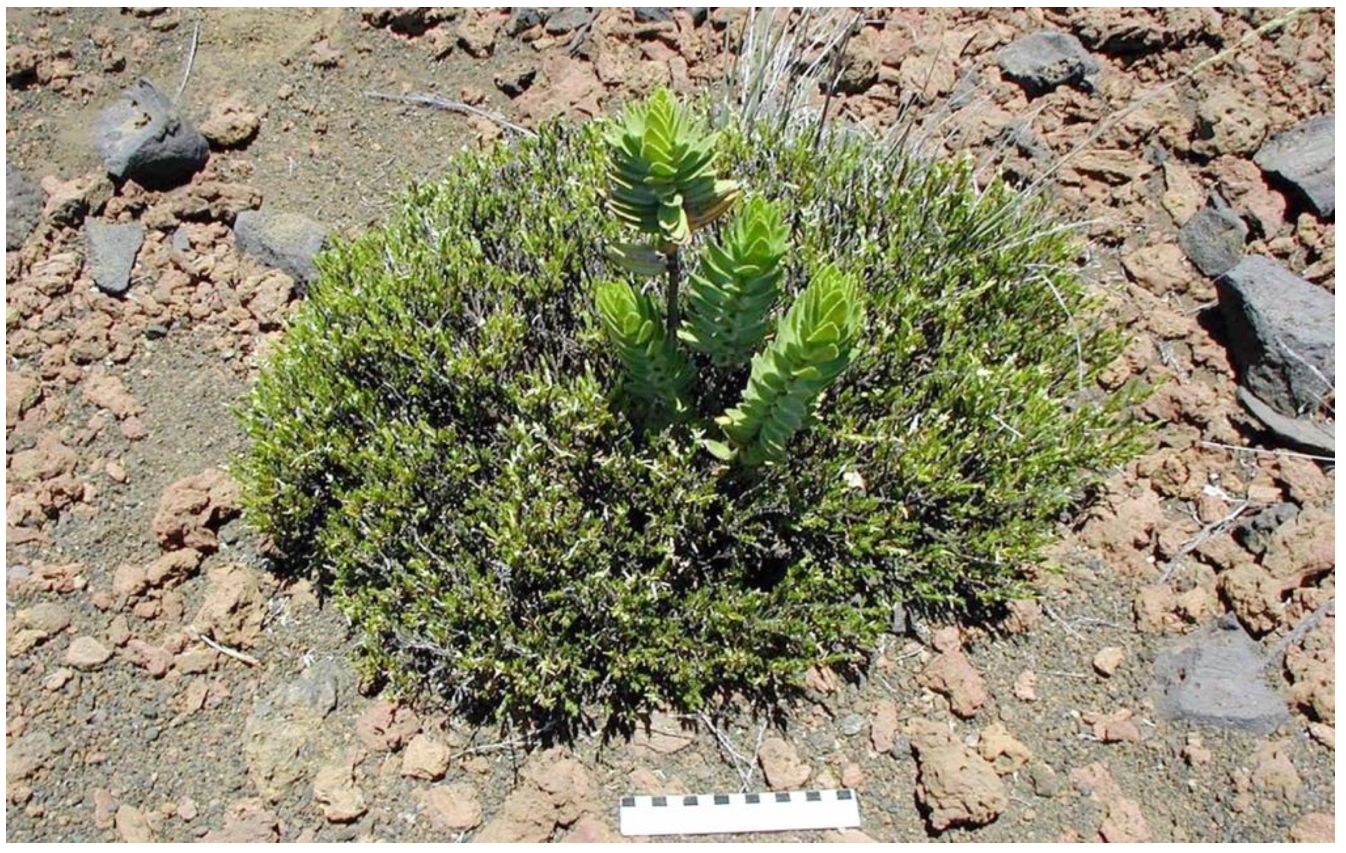
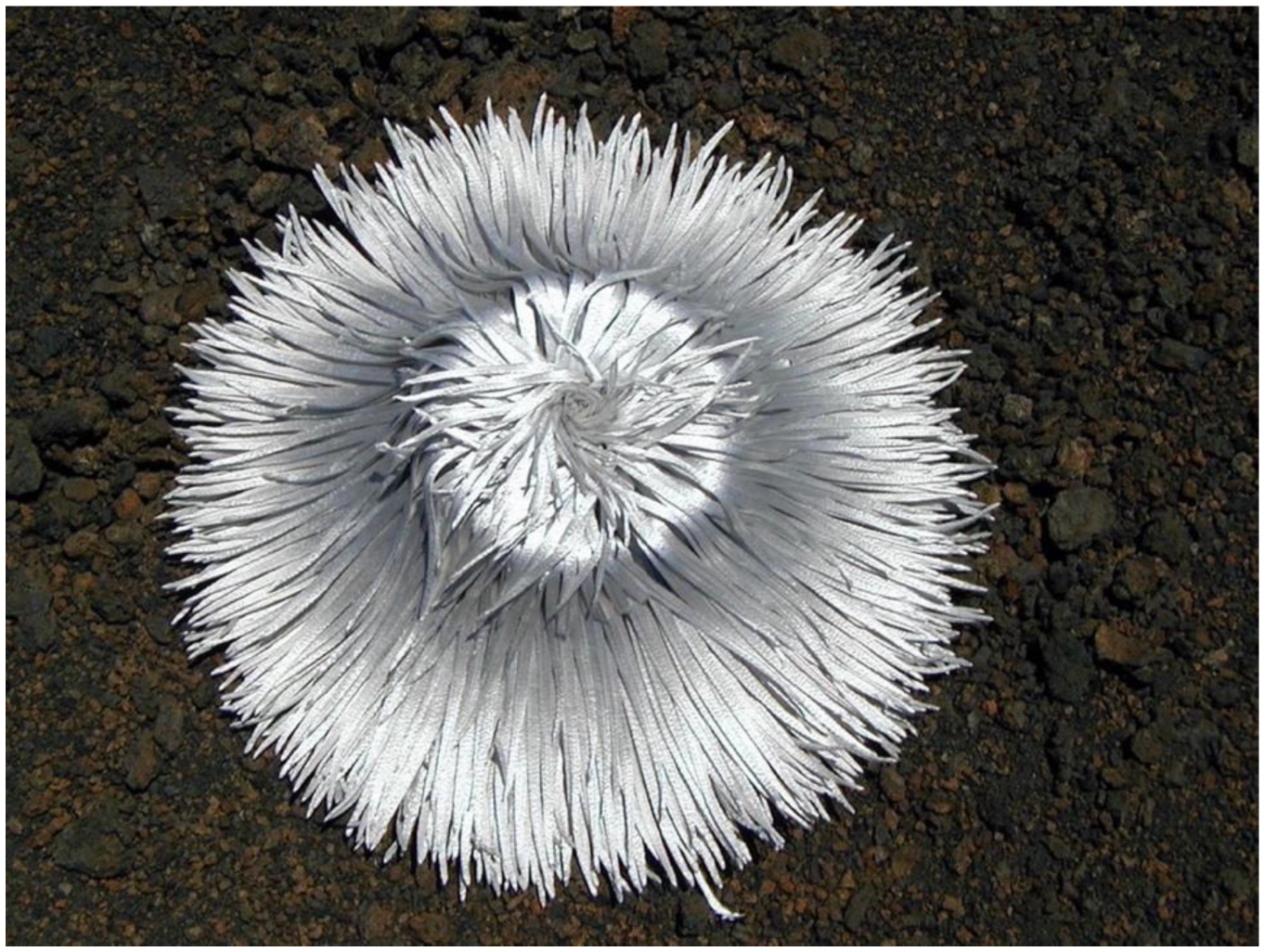

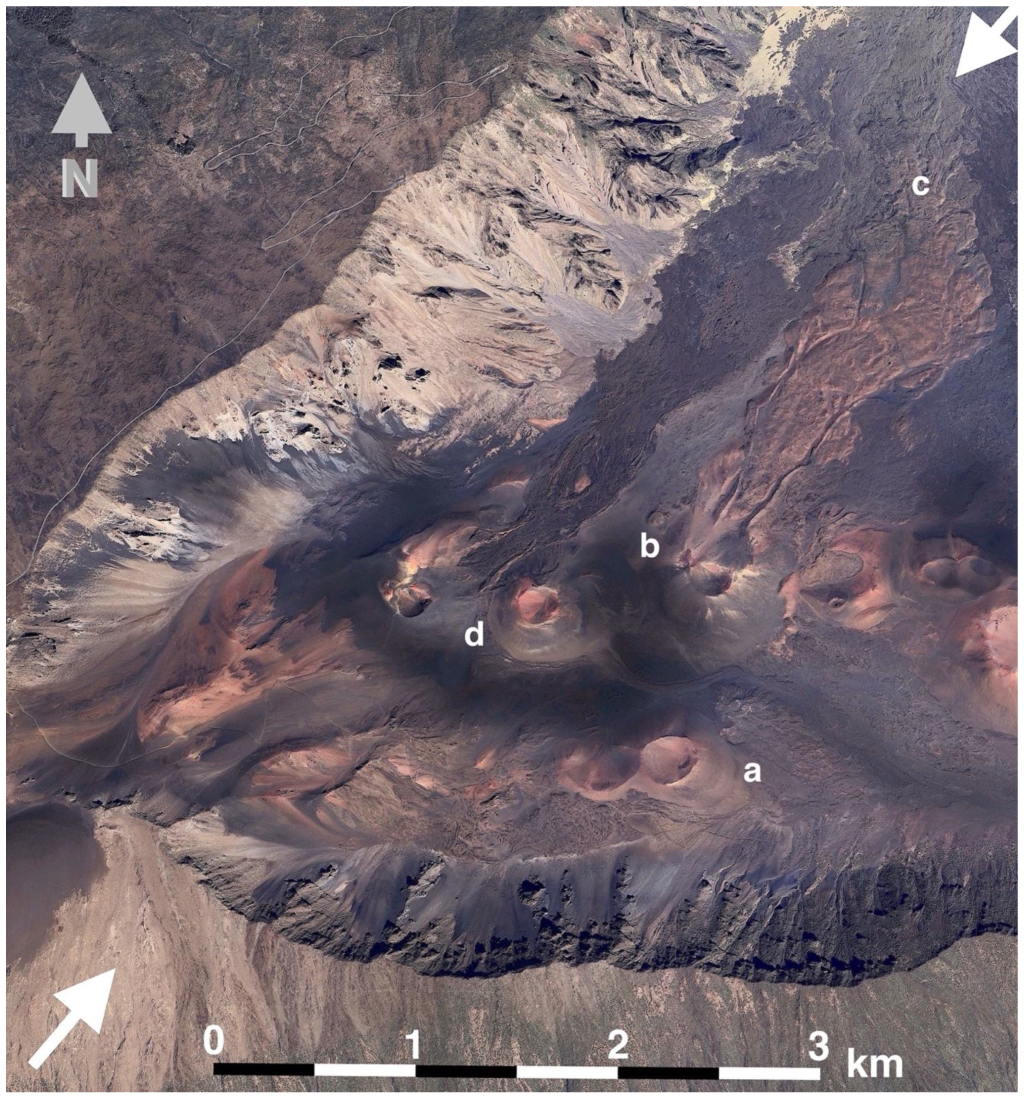

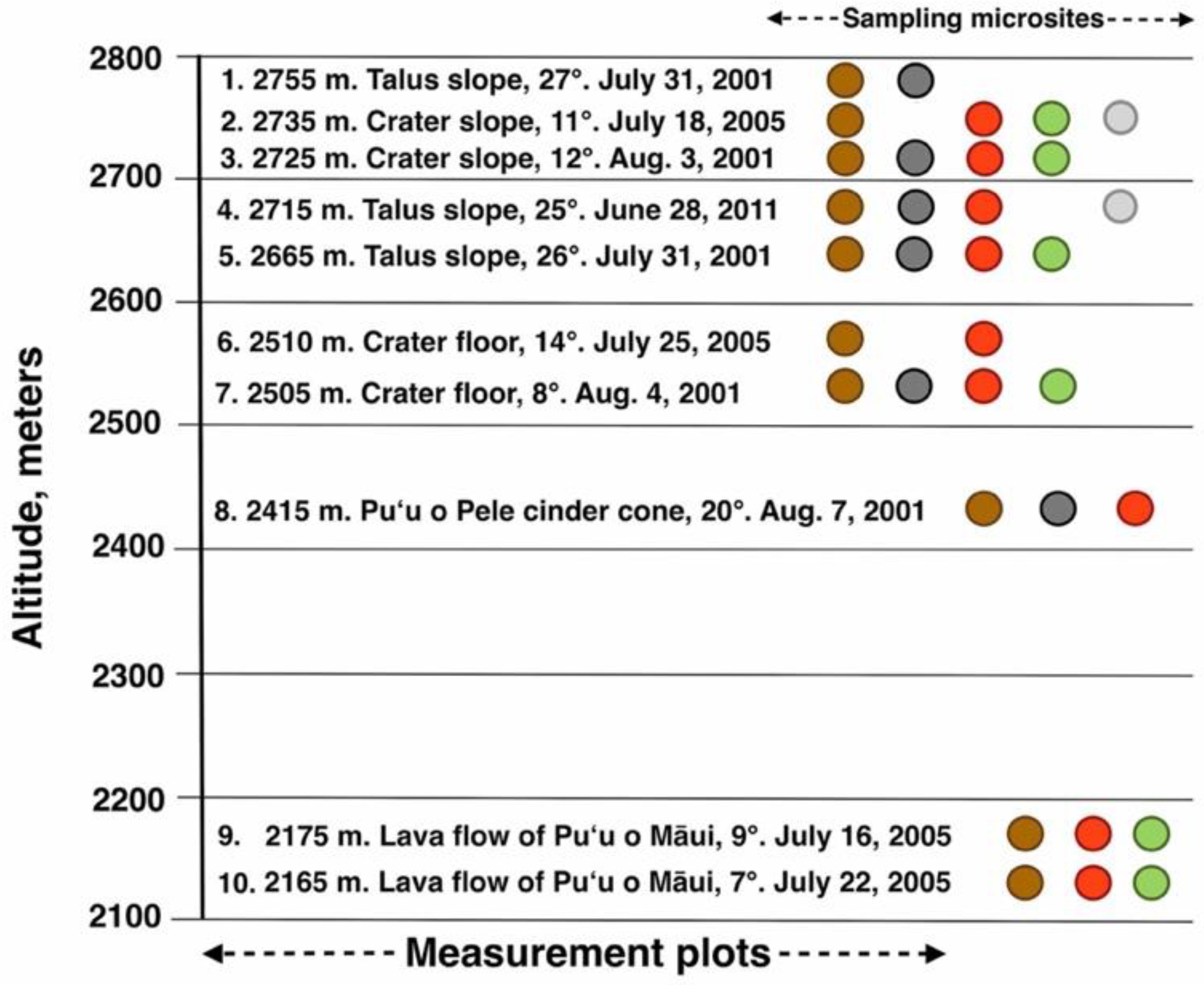
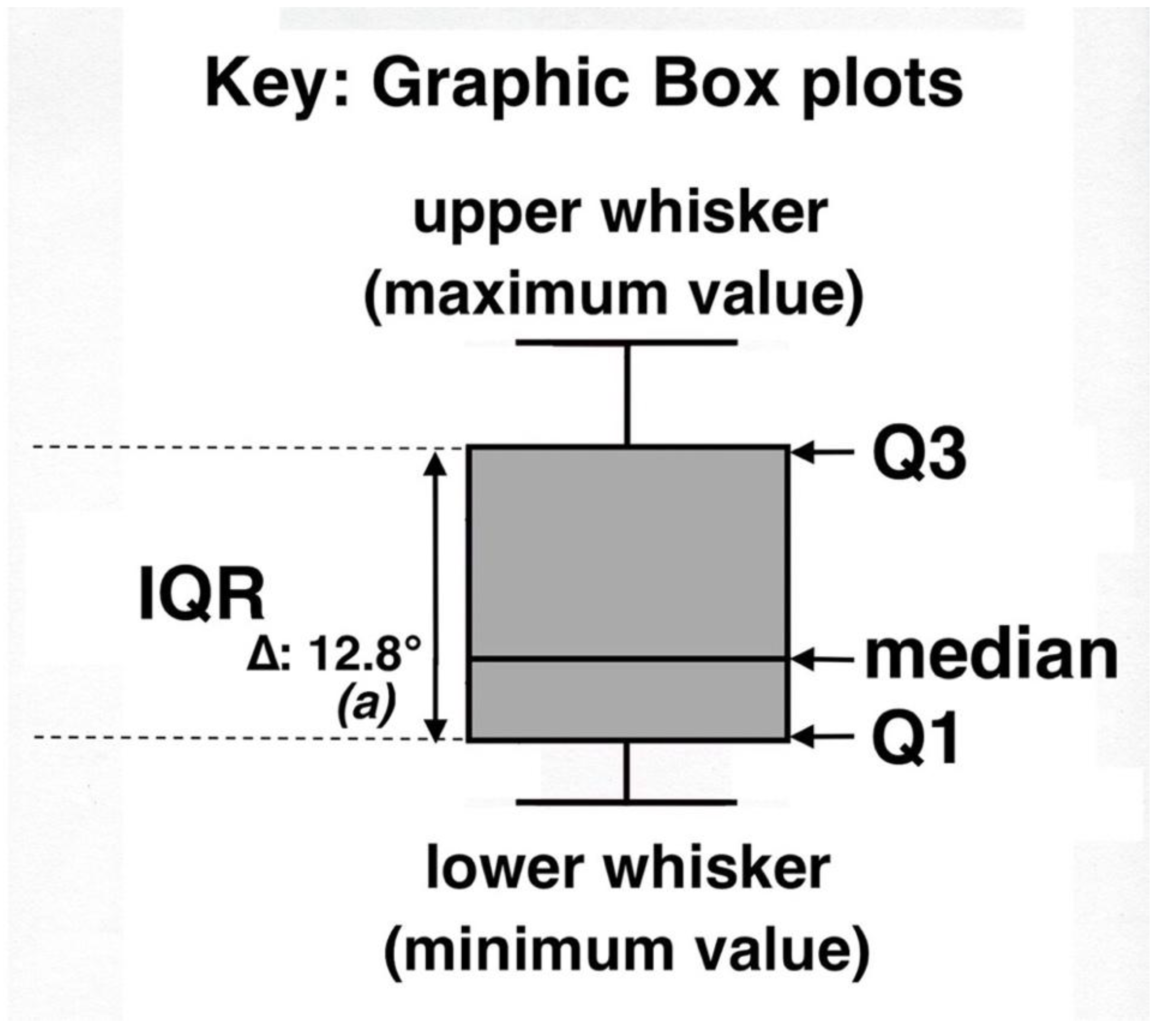
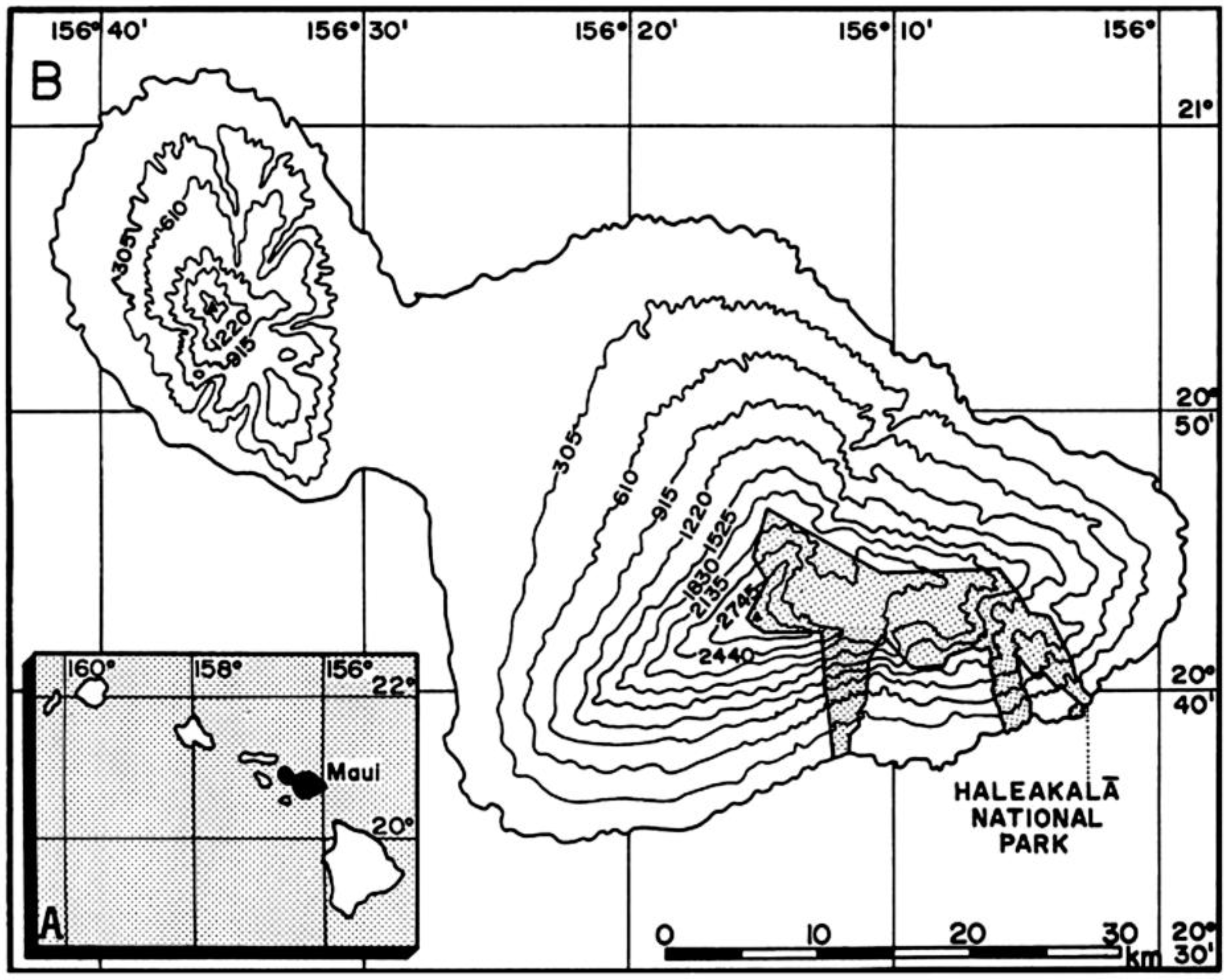
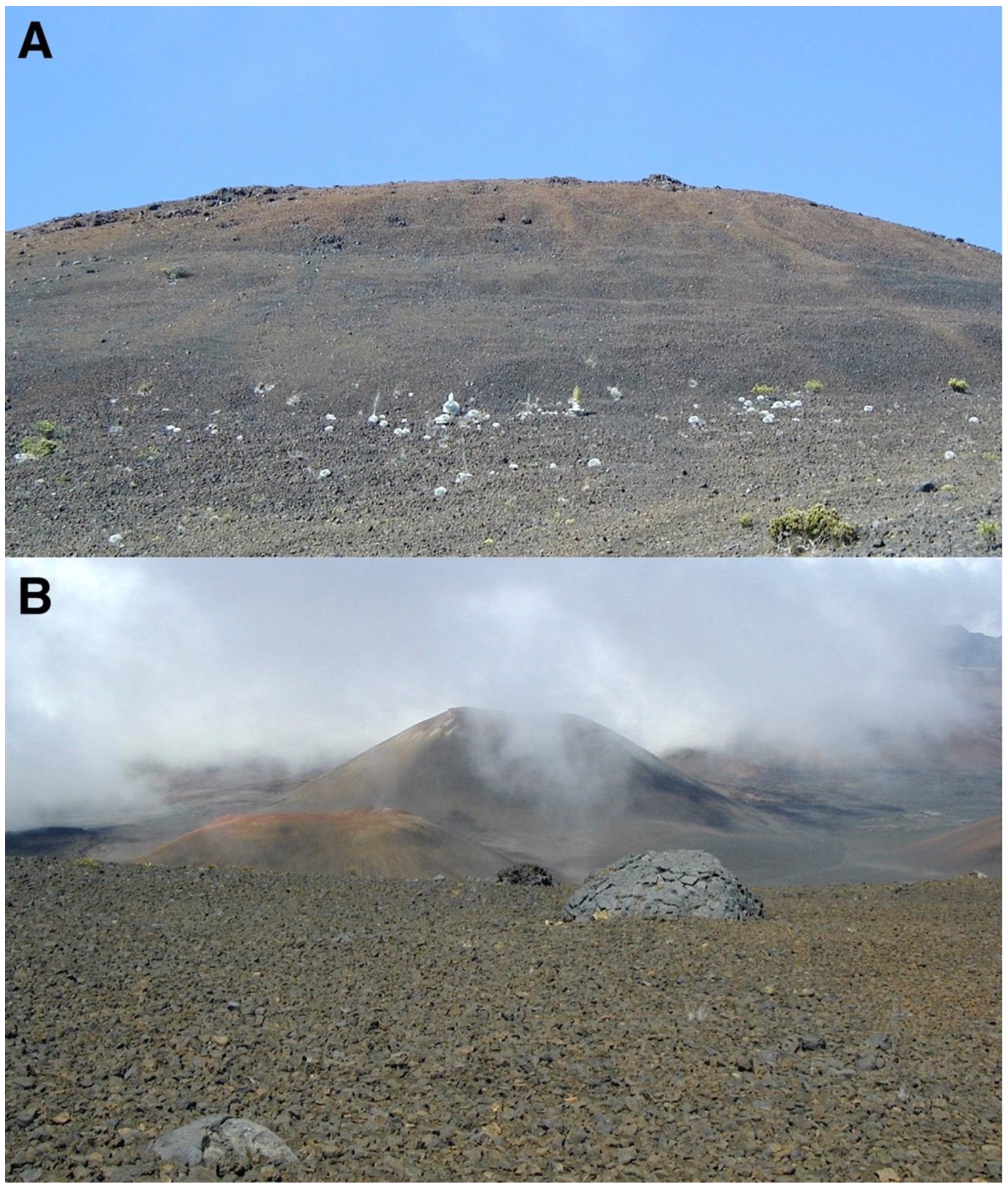

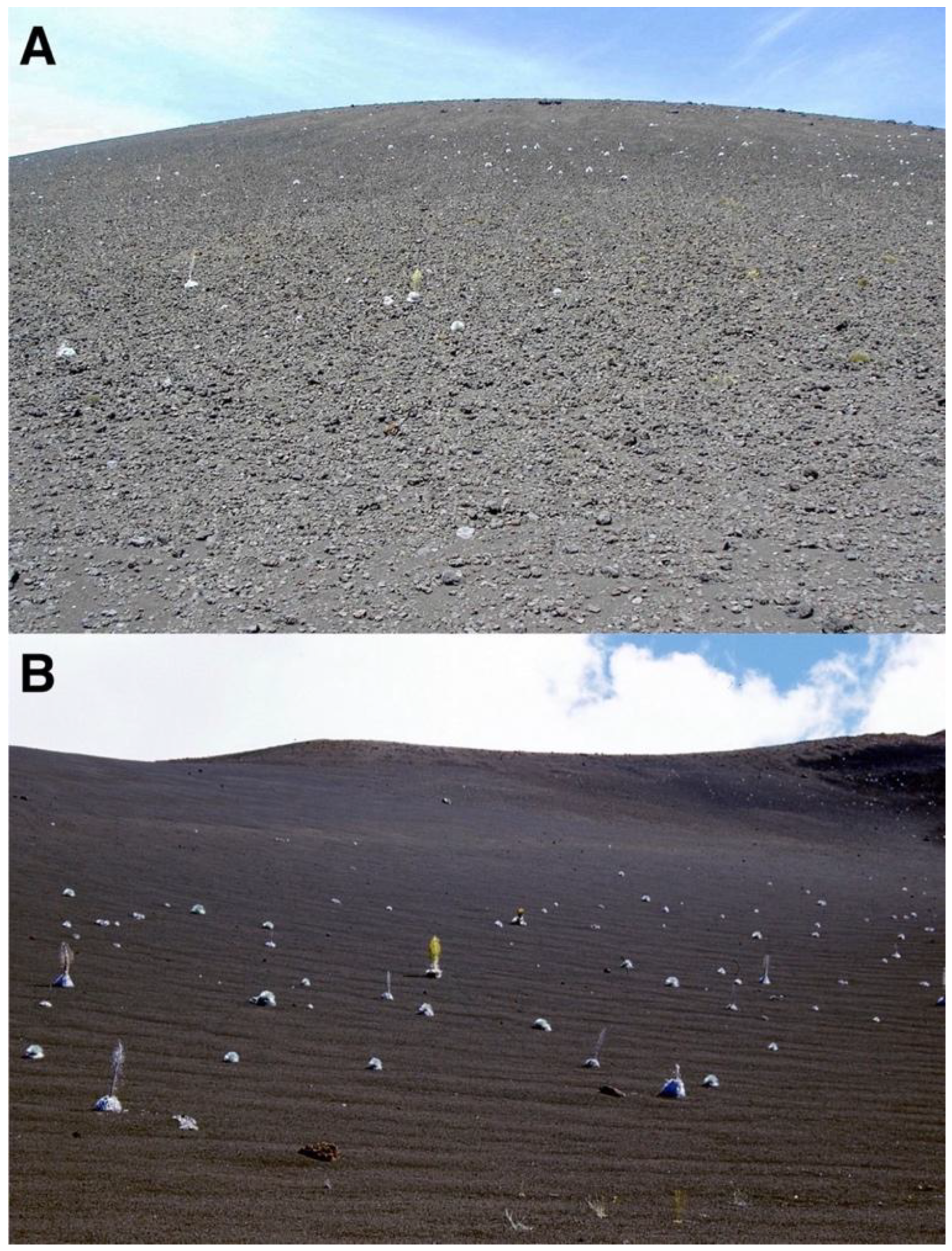
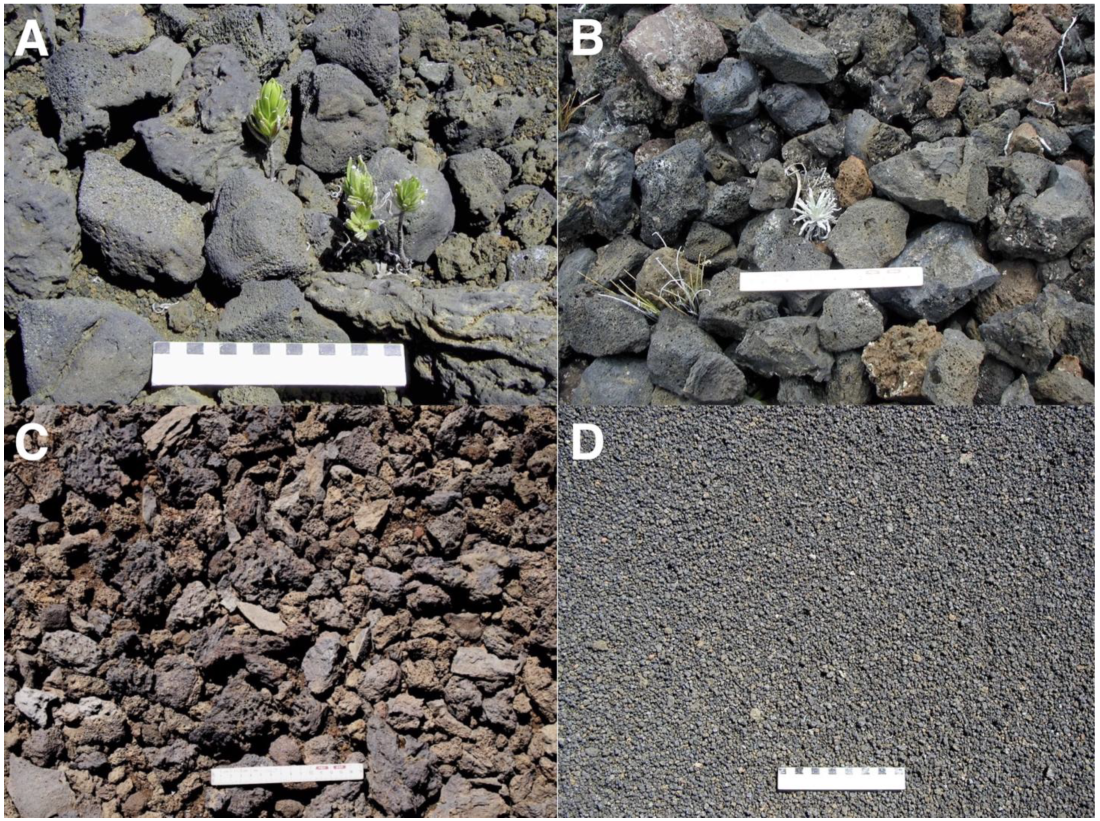
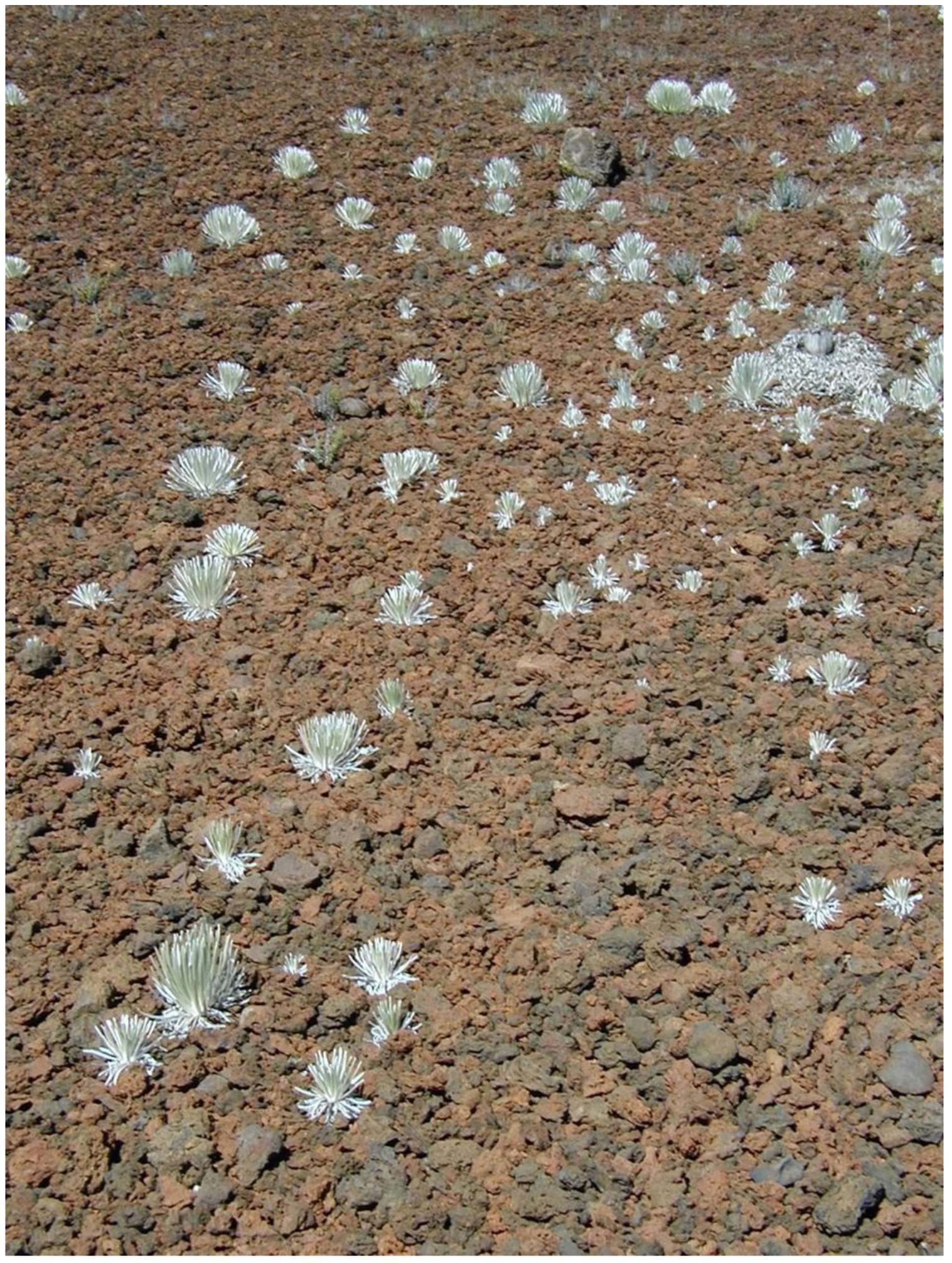
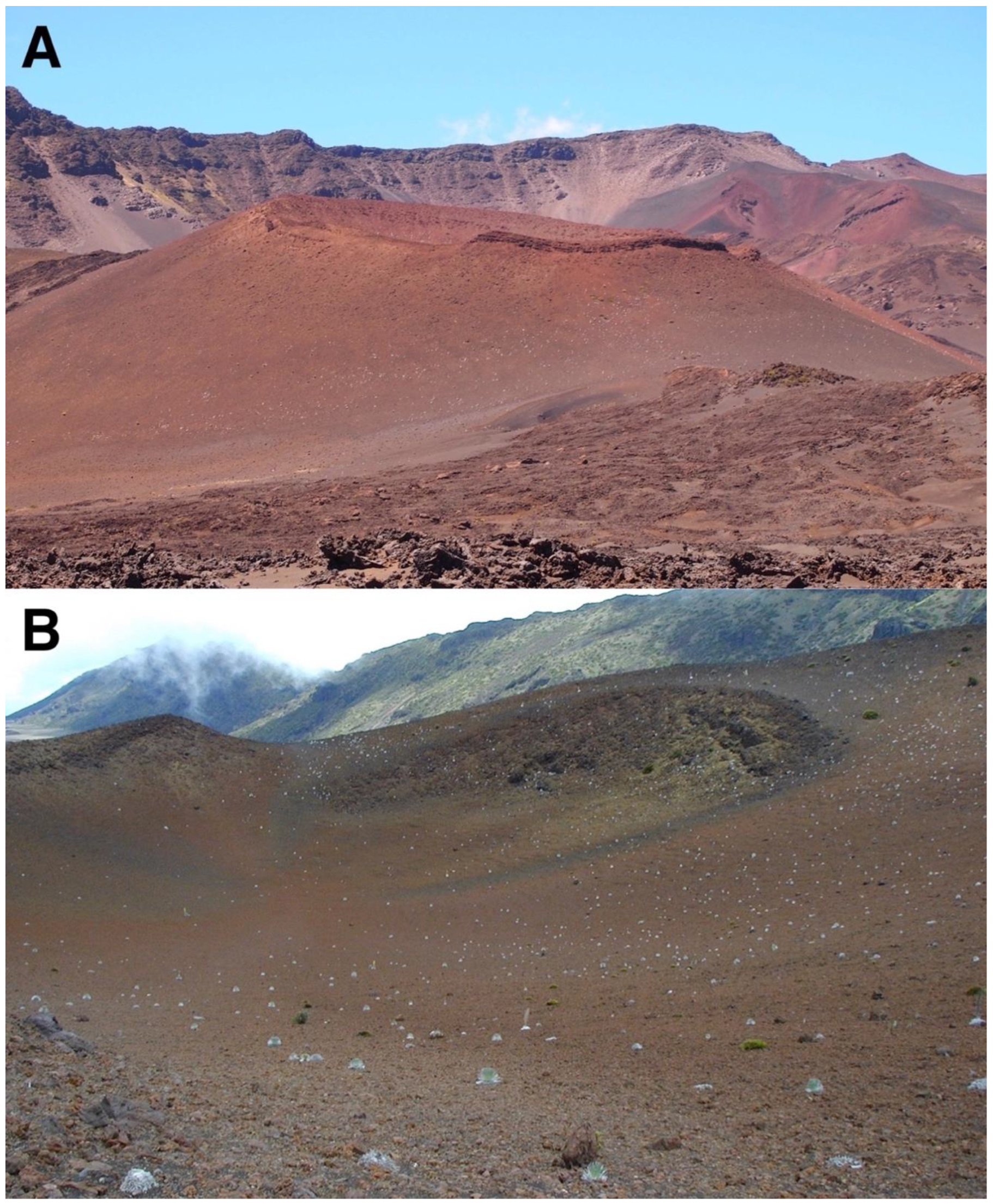
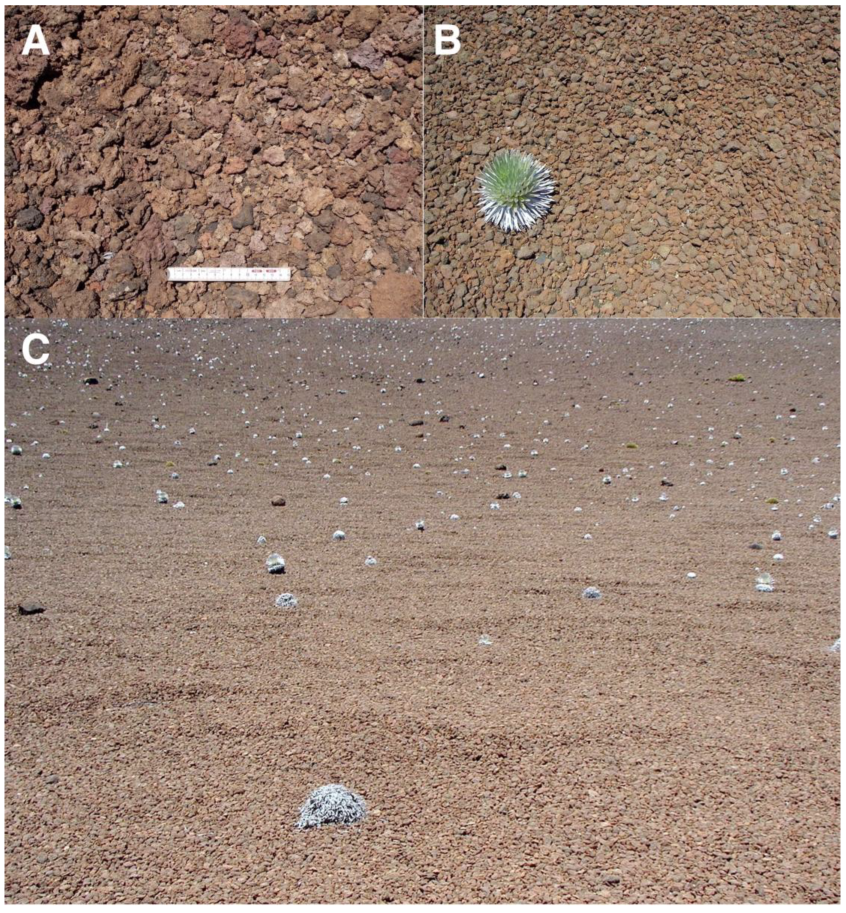

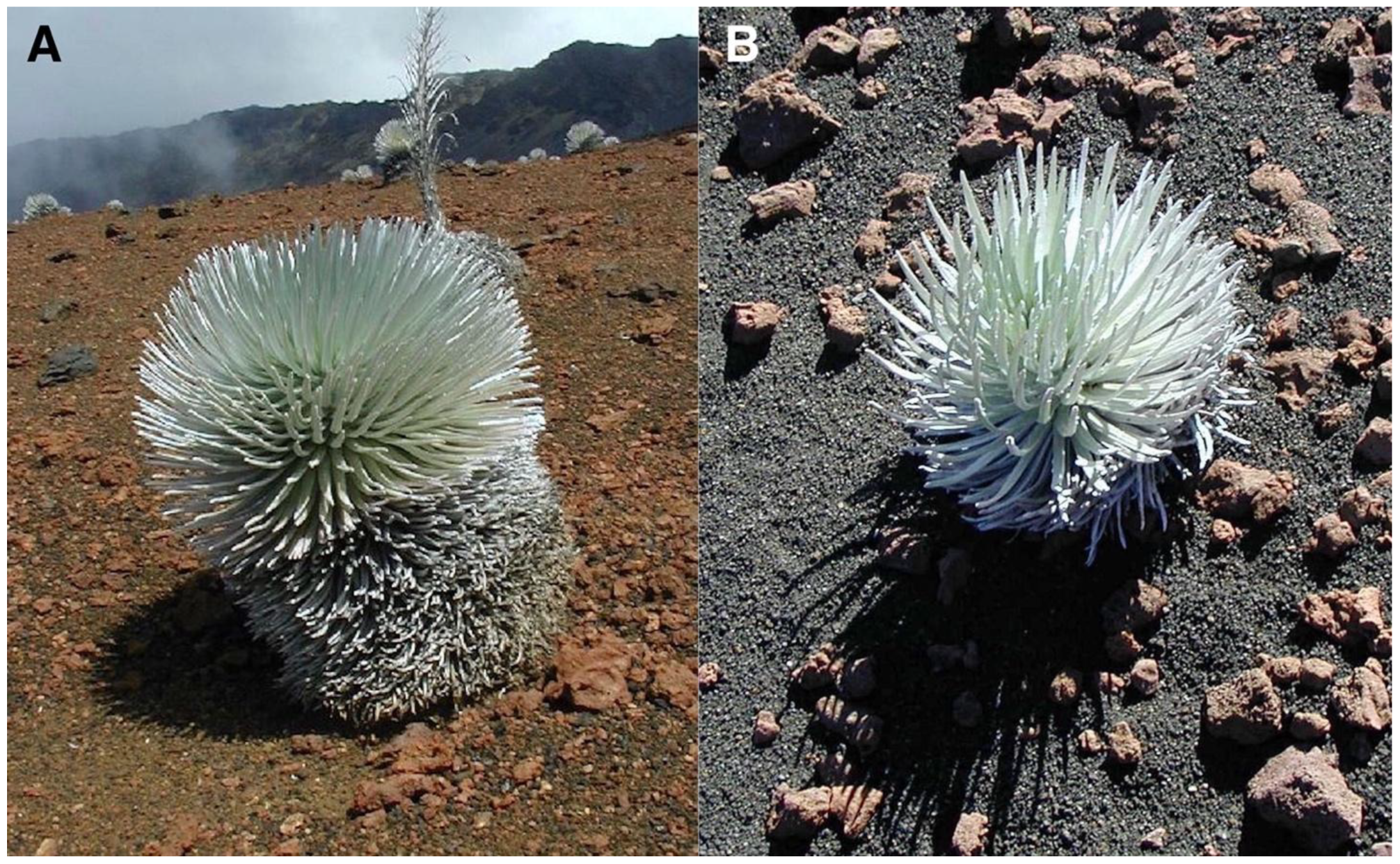
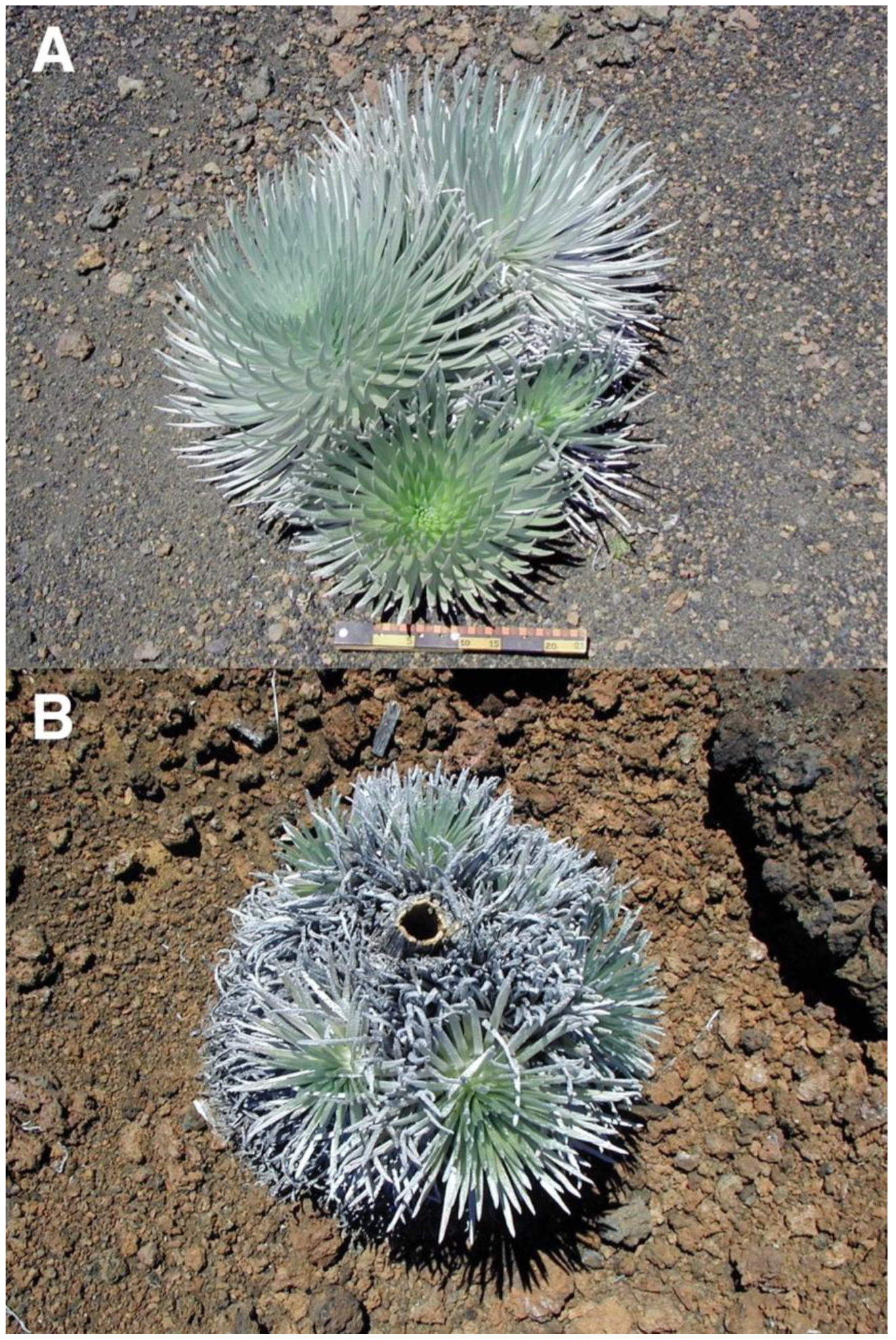
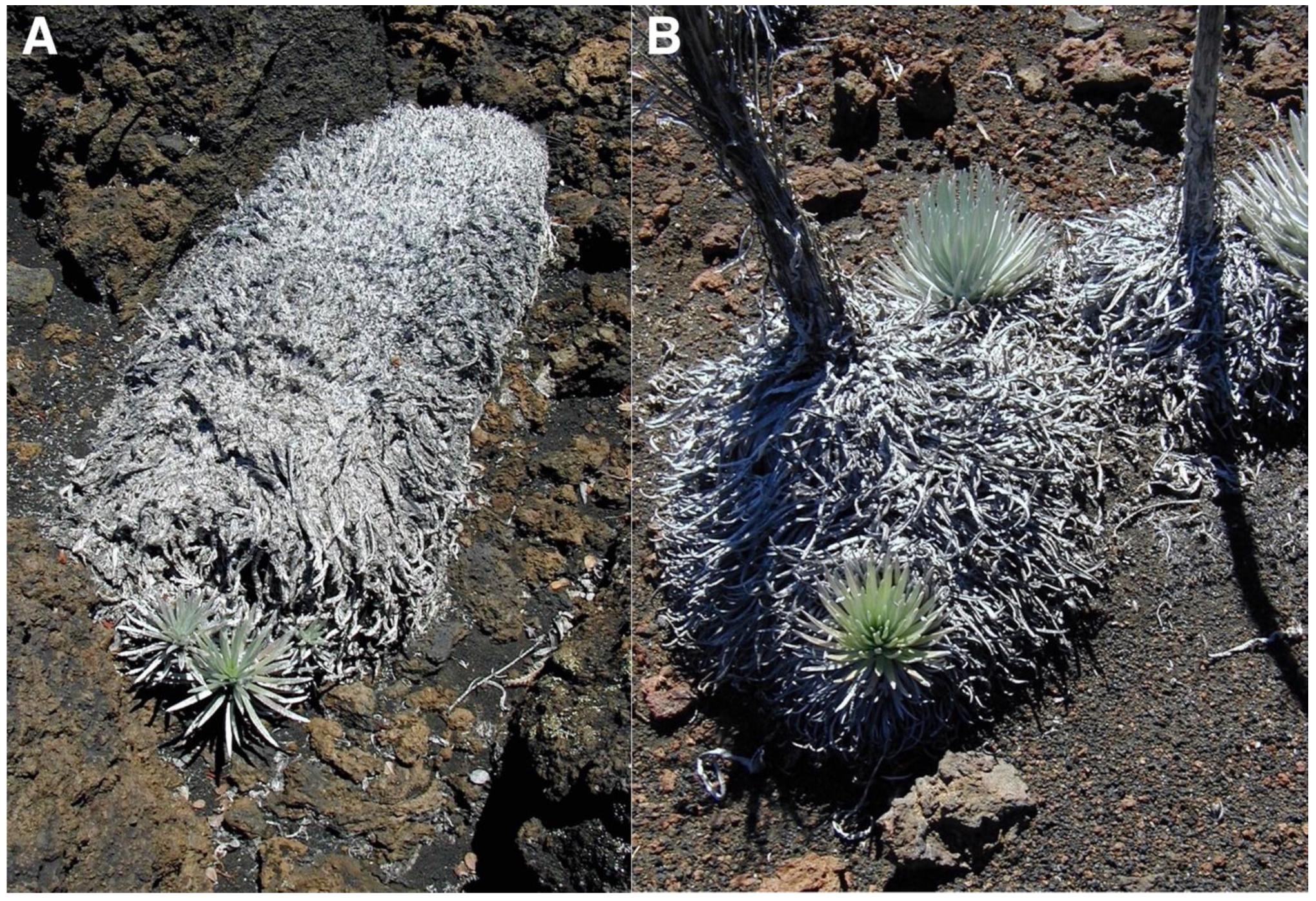

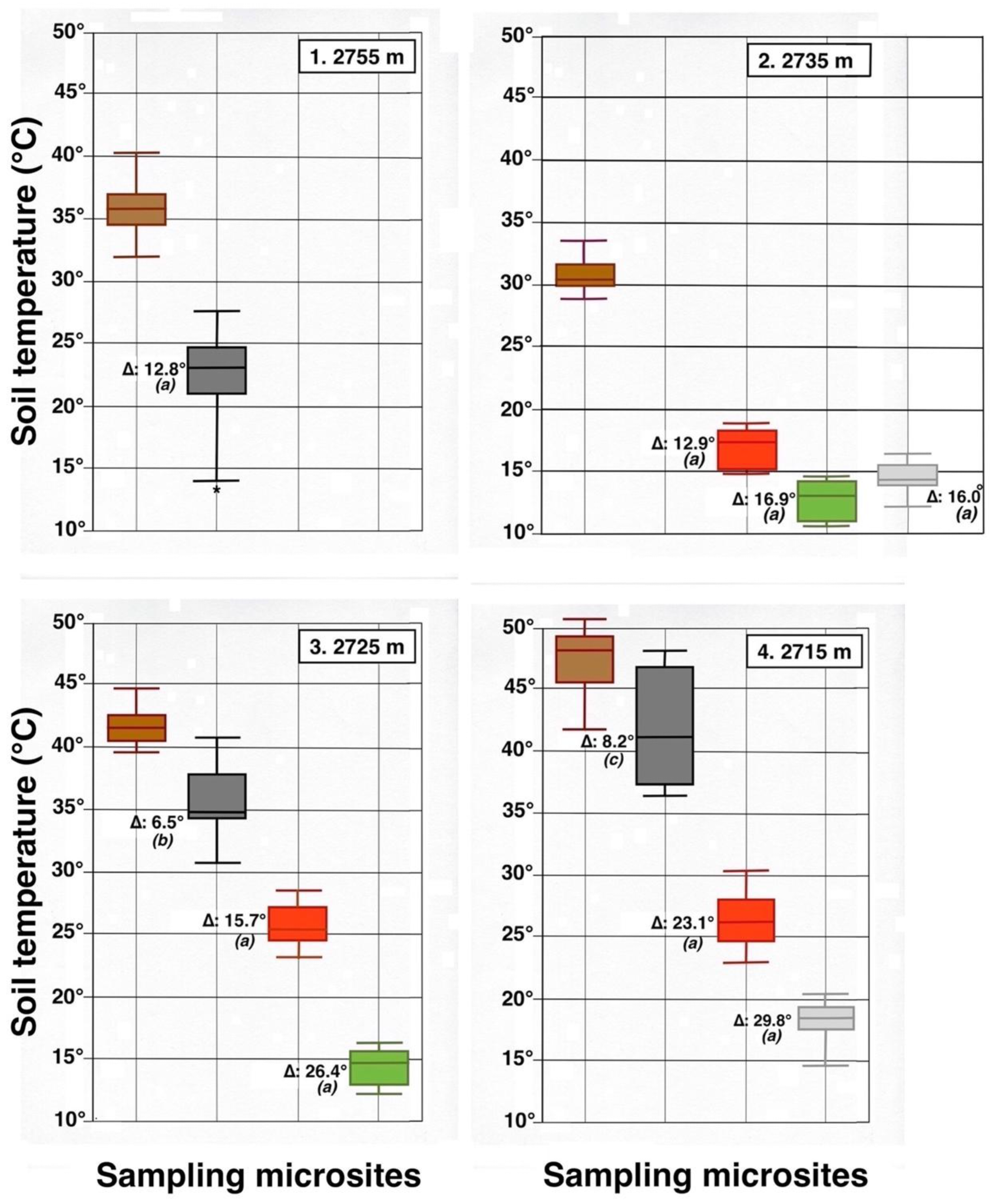
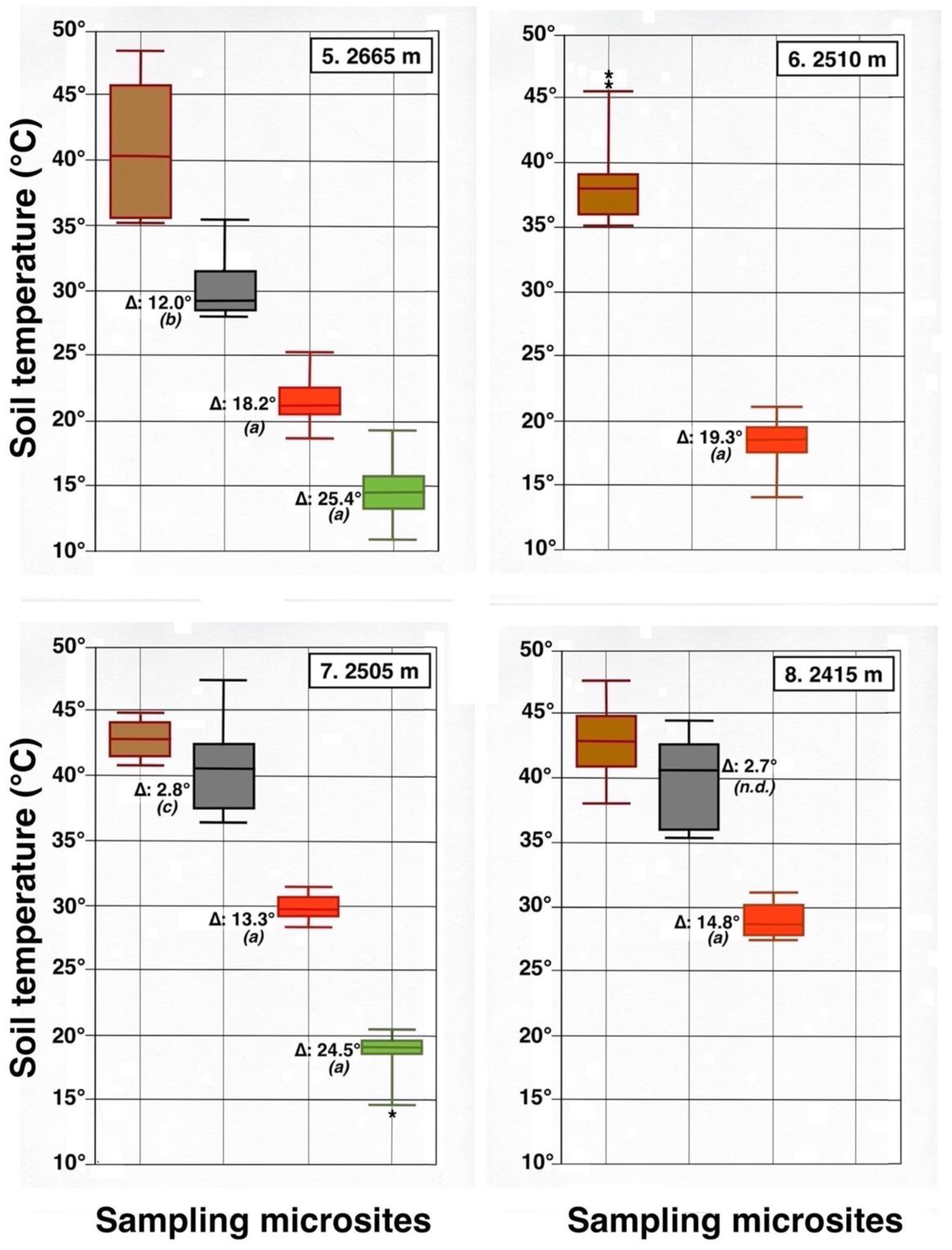
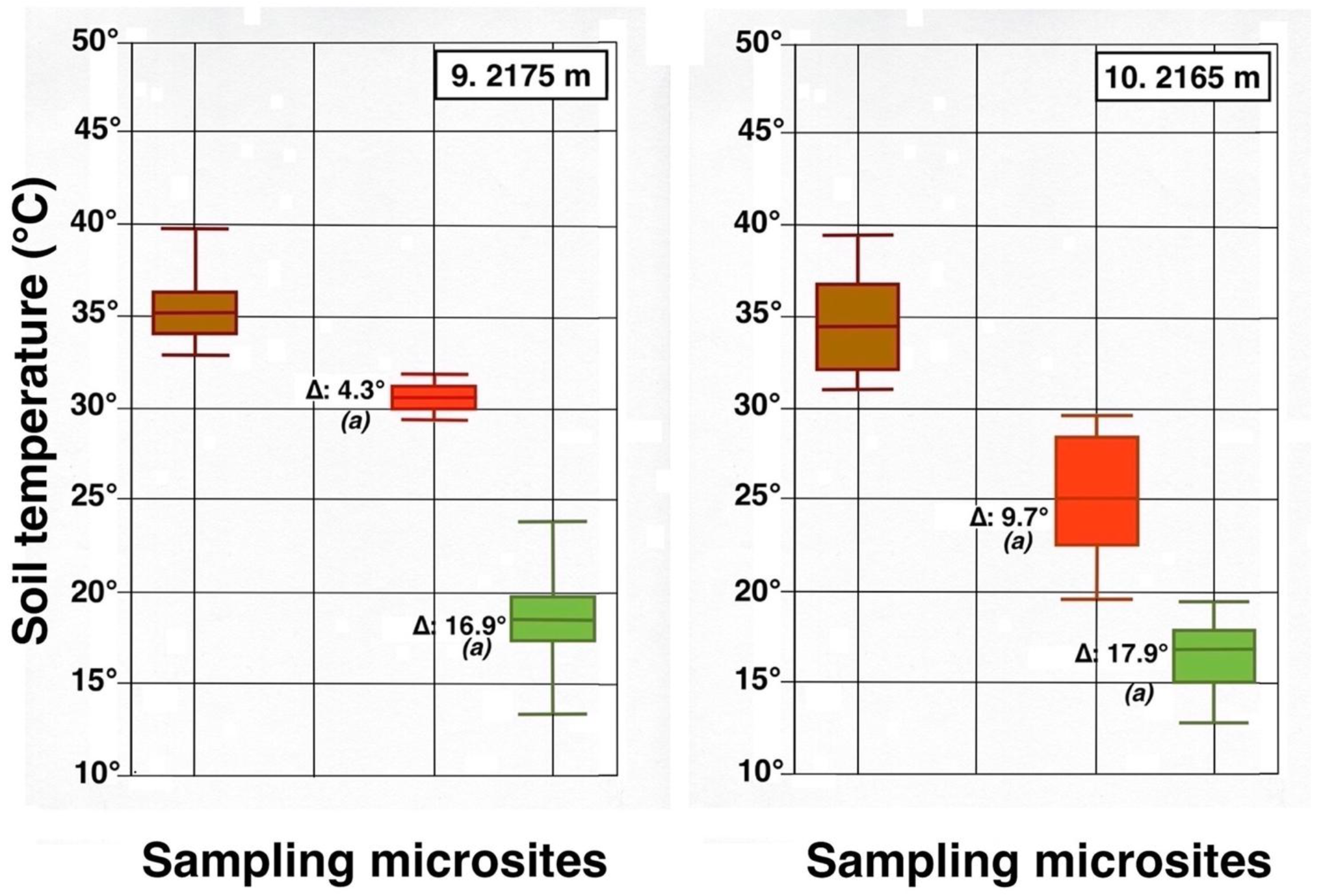
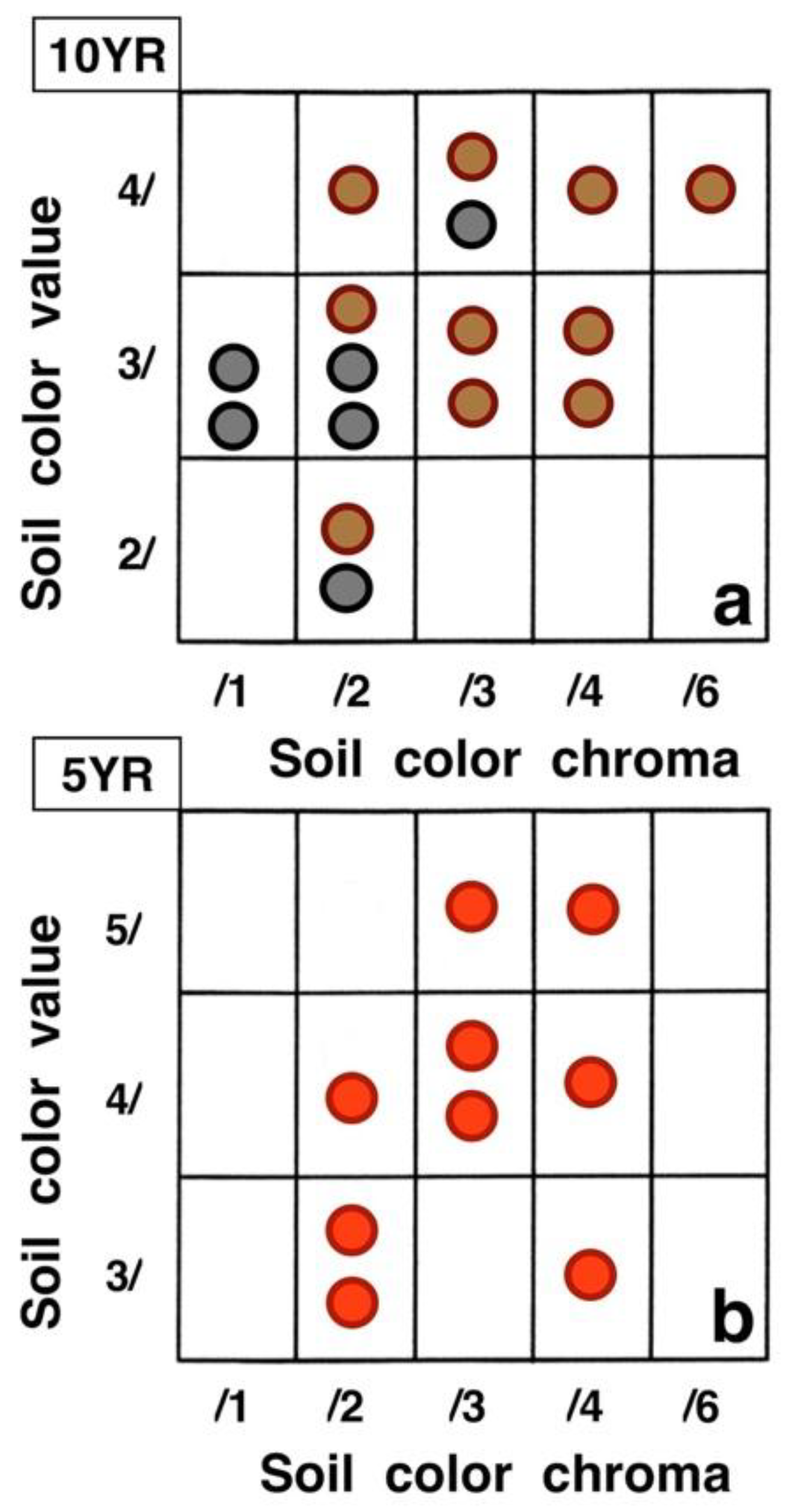

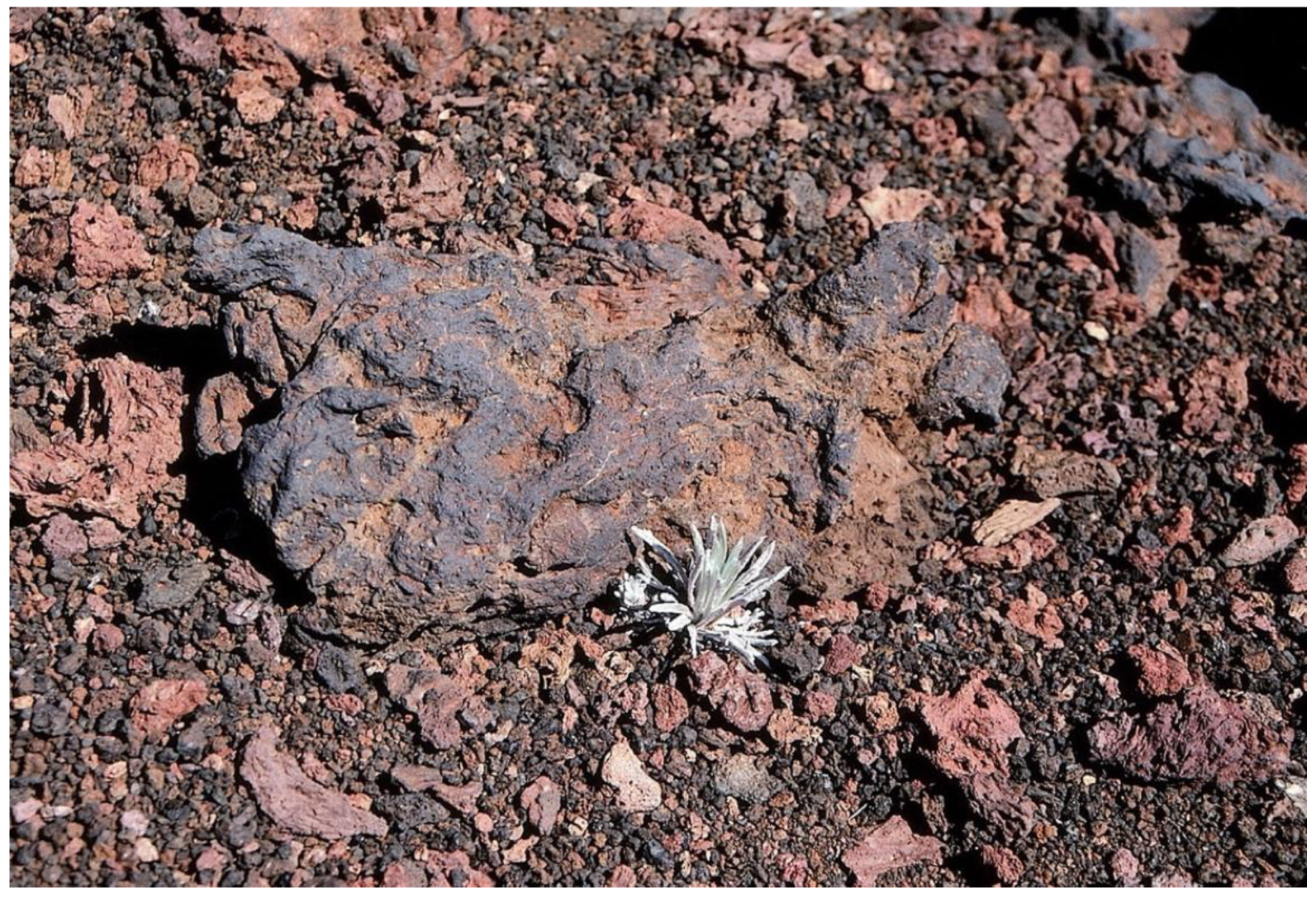
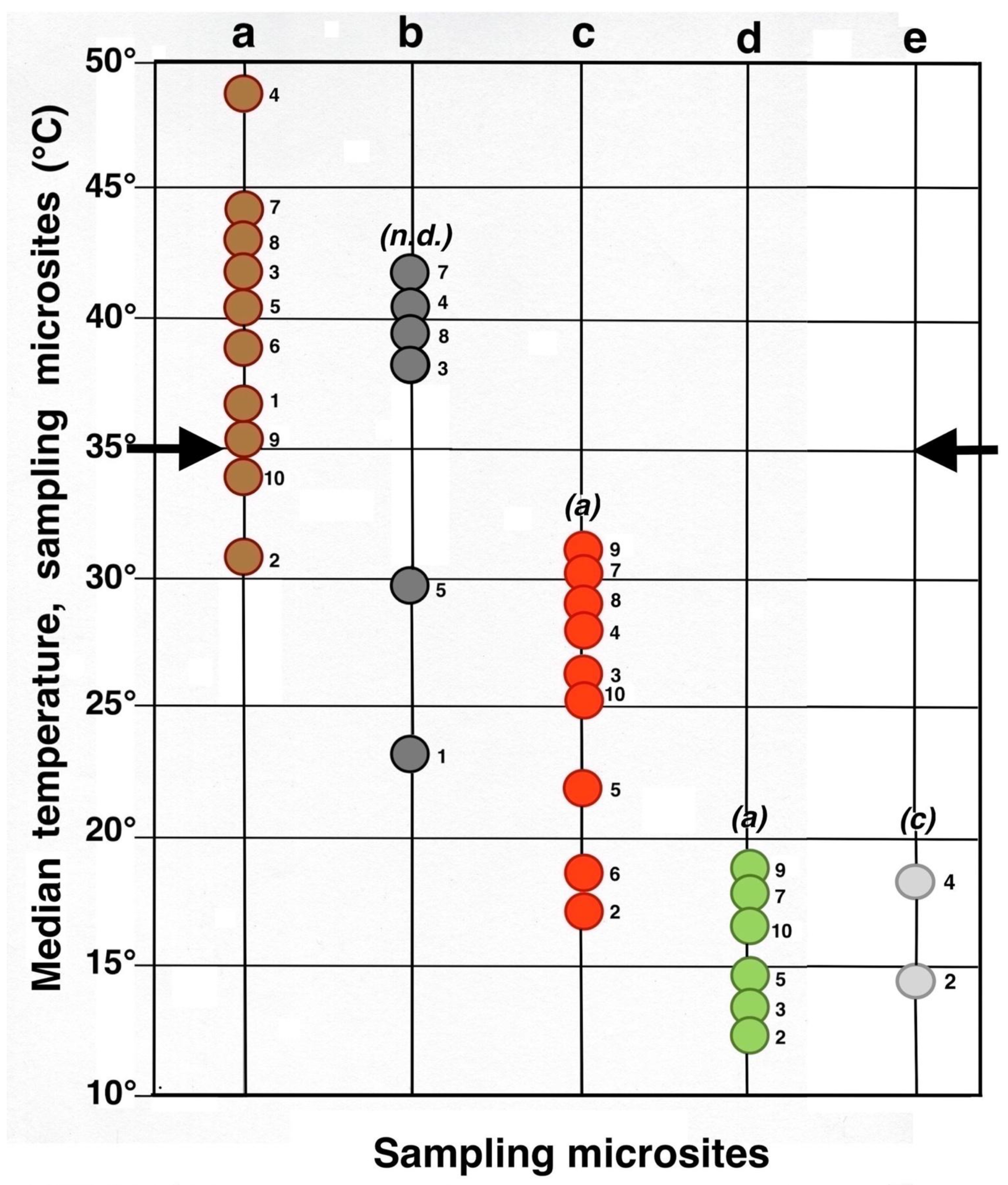
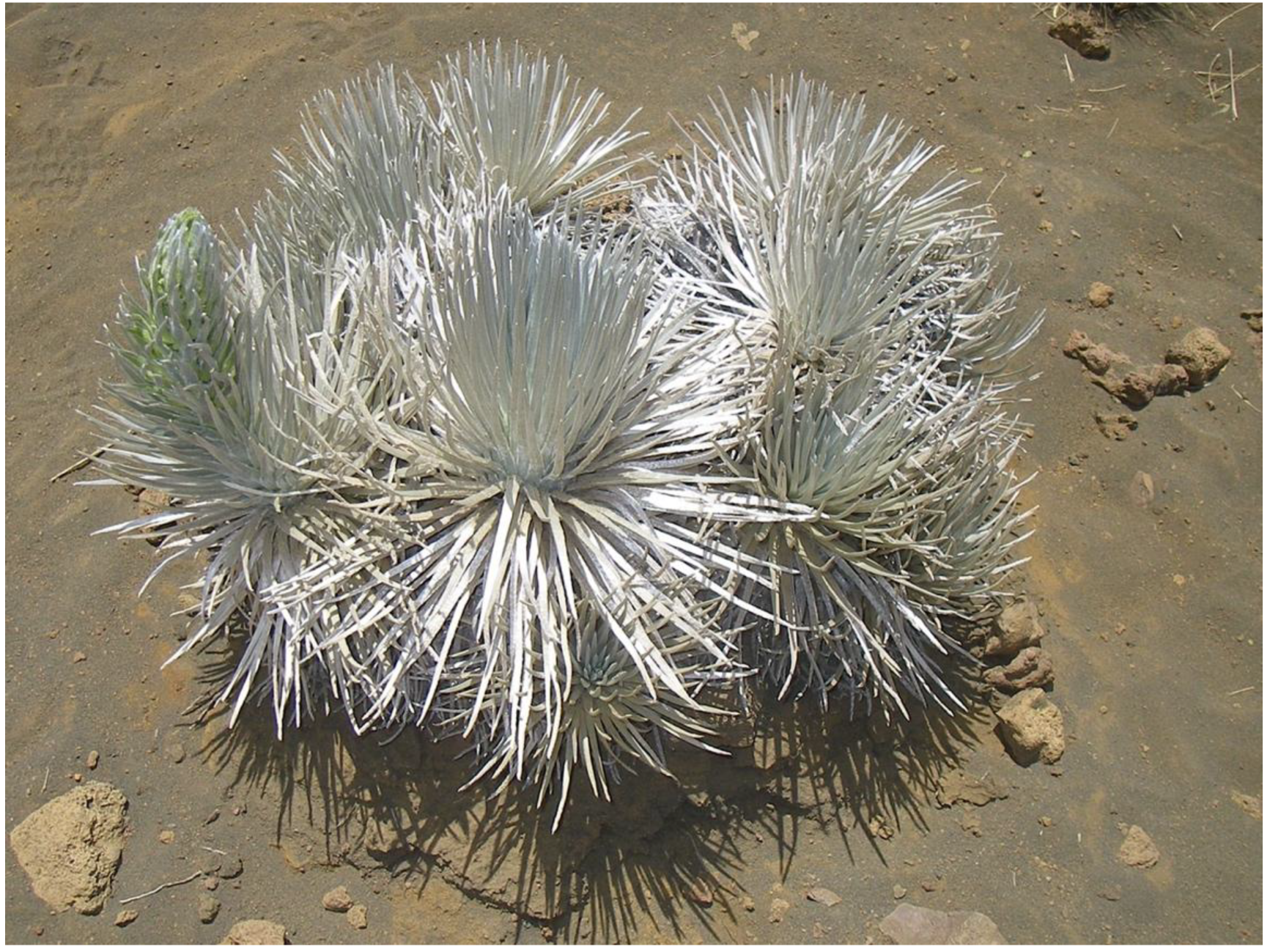
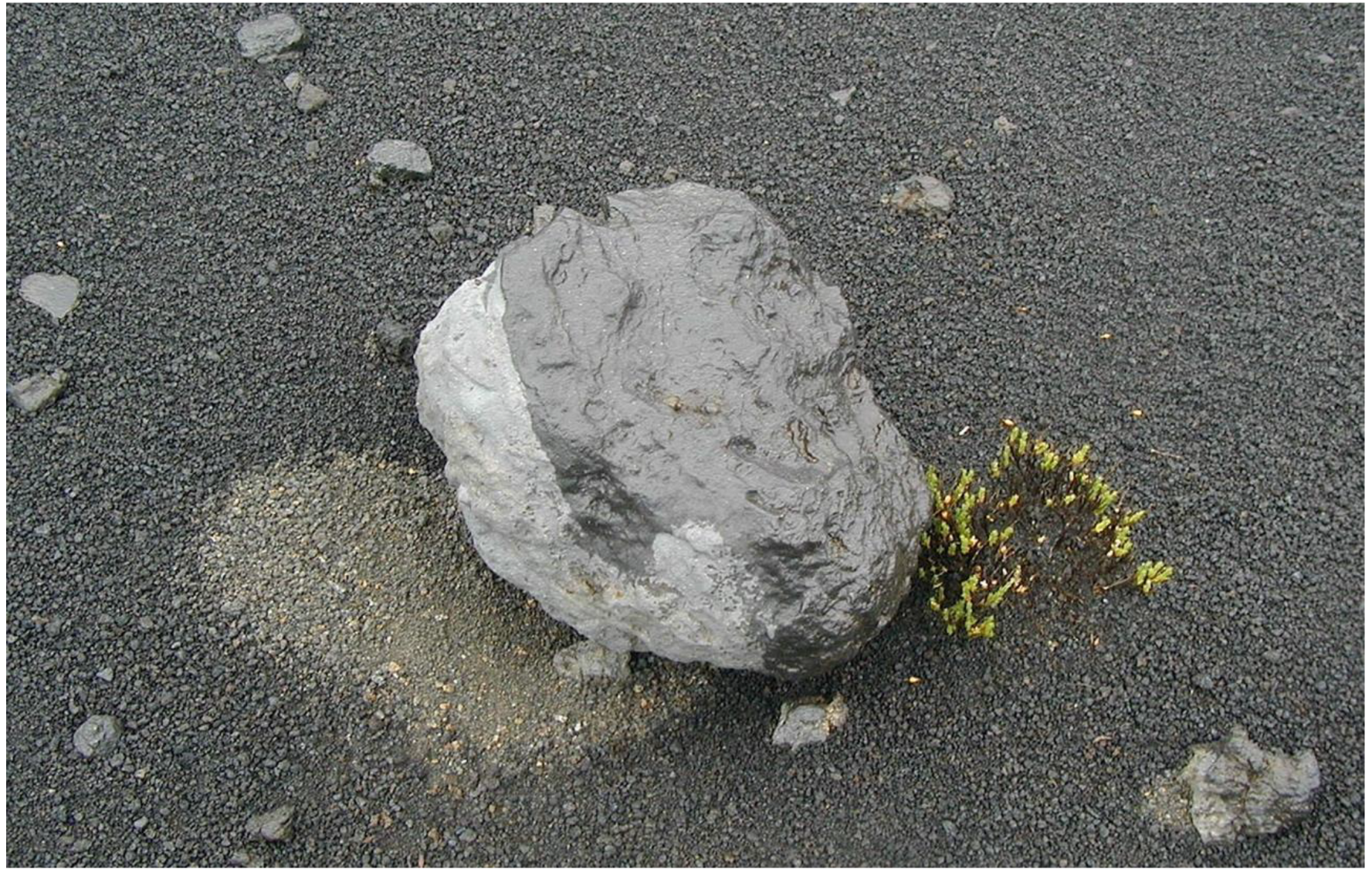
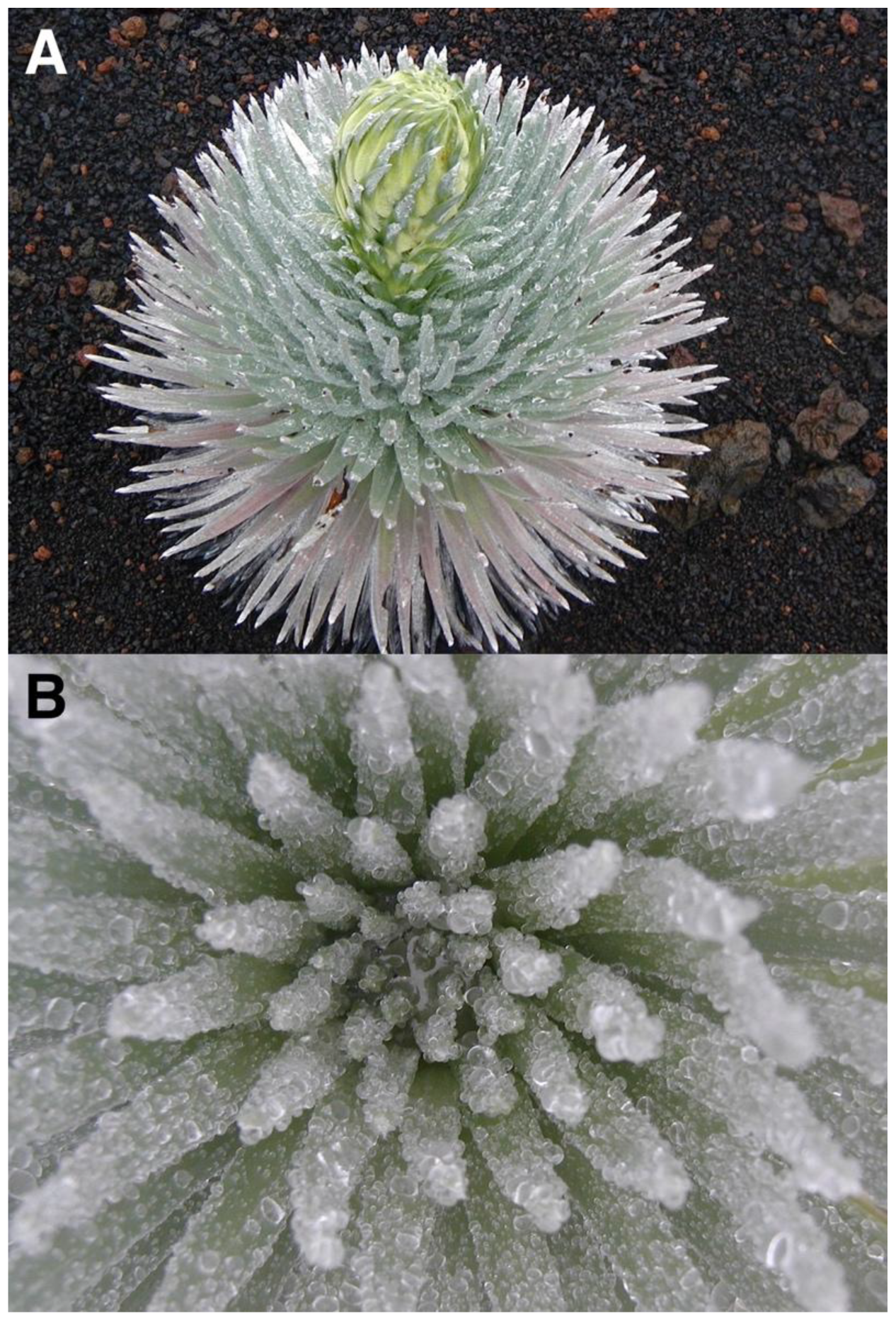

| Plot N | Altitude Meters | Azimuth Aspect (°) | N Microsites × Sets = Total | Black Tephra Color | Black Tephra Depth, mm ± S.D. | Reddish Tephra Color | Reddish Tephra Depth, mm ± S.D. | Rosette Height, cm ± S.D. | Rosette Diameter, cm ± S.D. | Organic Litter Thickness cm ± S.D. |
|---|---|---|---|---|---|---|---|---|---|---|
| 1 | 2755 | N20°NE | 20 × 2 = 40 | 10YR 2/2 | 37.6 ± 8.2 | - | - | - | - | - |
| 2 | 2735 | N28°NE | 10 × 4 = 40 | - | - | 5YR 5/3 | 33.0 ± 4.6 | 34.1 ± 6.3 | 35.1 ± 6.5 | 11.9 ± 2.6 |
| 3 | 2725 | N22°NE | 10 × 4 = 40 | 10YR 3/1 | 30.9 ± 10.7 | 5YR 4/3 | 39.6 ± 4.6 | 41.4 ± 9.8 | 41.8 ± 6.1 | - |
| 4 | 2715 | N30°NE | 15 × 4 = 60 | 10YR 3/1 | 27.2 ± 4.9 | 5YR 4/4 | 38.5 ± 4.8 | - | - | 19.1 ± 4.9 |
| 5 | 2665 | N15°NE | 10 × 4 = 40 | 10YR 4/3 | 22.5 ± 11.5 | 5YR 3/2 | 35.7 ± 7.2 | 38.6 ± 5.1 | 43.1 ± 7.7 | - |
| 6 | 2510 | E70°NE | 20 × 2 = 40 | - | - | 5YR 3/2 | 46.0 ± 19.2 | - | - | - |
| 7 | 2505 | E19°NE | 10 × 4 = 40 | 10YR 3/2 | 25.7 ± 9.8 | 5YR 4/2 | 36.6 ± 5.1 | 43.6 ± 8.8 | 47.8 ± 9.4 | - |
| 8 | 2415 | S163°SE | 10 × 3 = 30 | 10YR 3/2 | 38.6 ± 5.2 | 5YR 3/4 | 36.9 ± 5.6 | - | - | - |
| 9 | 2175 | 44°NE | 20 × 3 = 60 | - | - | 5YR 4/3 | 20.3 ± 7.0 | 38.9 ± 5.4 | 40.1 ± 5.6 | - |
| 10 | 2165 | 41°NE | 20 × 2 (+) 30 × 1 = 70 | - | - | 5YR 5/4 | 33.5 ± 13.7 | 41.8 ± 5.9 | 42.9 ± 6.3 | - |
| total | 460 |
| Plot N | Bare Soil Median | Bare Soil Mean ± S.D. | Black Tephra Median | Black Tephra Mean ± S.D. | Reddish Tephra Median | Reddish Tephra Mean ± S.D. | Rosette Shade Median | Rosette Shade Mean ± S.D. | Rosette Litter Median | Rosette Litter Mean ± S.D. |
|---|---|---|---|---|---|---|---|---|---|---|
| 1 | 35.9 | 35.7 ± 1.9 | 23.0 | 22.4 ± 3.6 | - | - | - | - | - | - |
| 2 | 30.4 | 30.8 ± 1.3 | - | - | 17.4 | 17.0 ± 1.0 | 13.4 | 13.3 ± 0.6 | 14.3 | 14.6 ± 1.6 |
| 3 | 41.5 | 41.8 ± 1.7 | 34.9 | 35.7 ± 2.8 | 25.8 | 25.9 ± 1.7 | 15.0 | 14.7 ± 0.9 | - | - |
| 4 | 48.7 | 48.4 ± 1.6 | 40.3 | 41.1 ± 3.7 | 25.8 | 26.1 ± 2.3 | - | - | 18.5 | 18.6 ± 1.3 |
| 5 | 40.2 | 40.9 ± 5.0 | 28.2 | 29.8 ± 3.0 | 22.0 | 21.9 ± 1.9 | 14.8 | 14.7 ± 2.0 | - | - |
| 6 | 37.7 | 38.1 ± 2.5 | - | - | 18.4 | 18.2 ± 1.7 | - | - | - | - |
| 7 | 43.2 | 43.1 ± 1.0 | 40.4 | 41.1 ± 3.7 | 29.9 | 29.9 ± 1.1 | 18.7 | 18.4 ± 1.6 | - | - |
| 8 | 43.5 | 43.1 ± 2.8 | 40.7 | 40.0 ± 3.1 | 28.6 | 28.9 ± 1.4 | - | - | - | - |
| 9 | 35.1 | 35.2 ± 1.39 | - | - | 30.8 | 30.7 ± 0.7 | 18.2 | 18.5 ± 2.4 | - | - |
| 10 | 34.7 | 34.6 ± 2.36 | - | - | 25.0 | 25.2 ± 3.2 | 16.8 | 16.6 ± 1.8 | - | - |
Disclaimer/Publisher’s Note: The statements, opinions and data contained in all publications are solely those of the individual author(s) and contributor(s) and not of MDPI and/or the editor(s). MDPI and/or the editor(s) disclaim responsibility for any injury to people or property resulting from any ideas, methods, instructions or products referred to in the content. |
© 2025 by the author. Licensee MDPI, Basel, Switzerland. This article is an open access article distributed under the terms and conditions of the Creative Commons Attribution (CC BY) license (https://creativecommons.org/licenses/by/4.0/).
Share and Cite
Pérez, F.L. Thermal Influence of Volcanic Tephra on Maximum Soil Temperatures: Geoecological Implications for Germination and Distribution of Argyroxiphium sandwicense (Haleakalā, Maui, Hawai’i). Geographies 2025, 5, 13. https://doi.org/10.3390/geographies5010013
Pérez FL. Thermal Influence of Volcanic Tephra on Maximum Soil Temperatures: Geoecological Implications for Germination and Distribution of Argyroxiphium sandwicense (Haleakalā, Maui, Hawai’i). Geographies. 2025; 5(1):13. https://doi.org/10.3390/geographies5010013
Chicago/Turabian StylePérez, Francisco Luis. 2025. "Thermal Influence of Volcanic Tephra on Maximum Soil Temperatures: Geoecological Implications for Germination and Distribution of Argyroxiphium sandwicense (Haleakalā, Maui, Hawai’i)" Geographies 5, no. 1: 13. https://doi.org/10.3390/geographies5010013
APA StylePérez, F. L. (2025). Thermal Influence of Volcanic Tephra on Maximum Soil Temperatures: Geoecological Implications for Germination and Distribution of Argyroxiphium sandwicense (Haleakalā, Maui, Hawai’i). Geographies, 5(1), 13. https://doi.org/10.3390/geographies5010013






